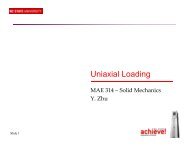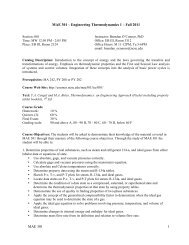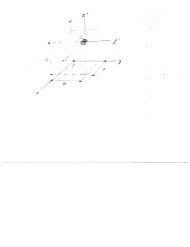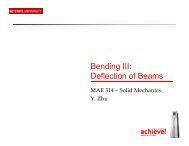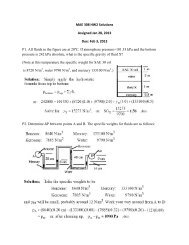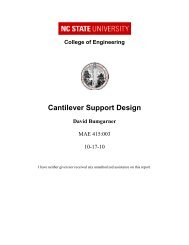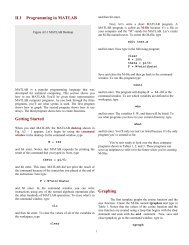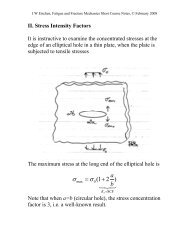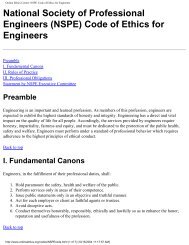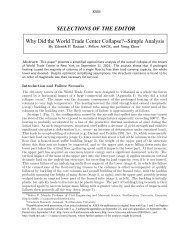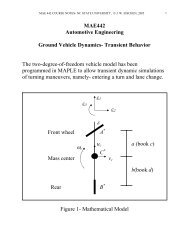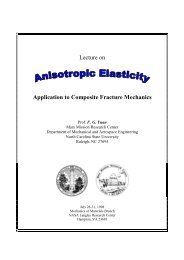ME ABET Syllabus - Department of Mechanical and Aerospace ...
ME ABET Syllabus - Department of Mechanical and Aerospace ...
ME ABET Syllabus - Department of Mechanical and Aerospace ...
You also want an ePaper? Increase the reach of your titles
YUMPU automatically turns print PDFs into web optimized ePapers that Google loves.
CSC 112 <strong>Syllabus</strong>Course: CSC 112Credit Hours: 3Course Title:Introduction to Computing - FORTRANCourse Description:Problem solving through writing FORTRAN programs. Particular elements include: carefuldevelopment <strong>of</strong> FORTRAN programs from specifications; documentation <strong>and</strong> style; appropriateuse <strong>of</strong> control structures, data types <strong>and</strong> subprograms; abstraction <strong>and</strong> verification; engineeringapplications.Prerequisite(s): E 115, MA 141Textbook(s) <strong>and</strong>/or other required material:Fortran 95/2003 for Scientists <strong>and</strong> Engineers, Stephen J. Chapman, McGraw-Hill, Third Edition,2008.Course objectives. By the end <strong>of</strong> this course, the student should be able to (usedemonstrative verbs):Upon successful completion <strong>of</strong> this course, a student will be able to solve problems throughwriting FORTRAN programs. Students are expected to be able to develop FORTRAN programsfrom specifications <strong>and</strong> document those programs in a style permitting the maintaining <strong>and</strong>altering <strong>of</strong> the programs by a third party. Students will underst<strong>and</strong> the use <strong>of</strong> control structures,data types, input <strong>and</strong> output processes, <strong>and</strong> both recursive <strong>and</strong> nonrecursive subprograms, <strong>and</strong> theuse <strong>of</strong> modules. Students will know how to verify that programs are running correctly, <strong>and</strong> willbe equipped to write FORTRAN programs for engineering applications.Students will comprehend some <strong>of</strong> the theory that underpins computation <strong>and</strong> the FORTRANfamily <strong>of</strong> programming languages including number systems <strong>and</strong> representations in thecomputer, machine language protocols (e.g., floating point representations), program correctness,automata theory (e.g., Turing machines), formal languages (e.g., Chomsky hierarchy) <strong>and</strong>recursion.Topics covered:Programming structures, variable/data types, read/write/print statements, debugging/errorcorrectionsIF StatementsDO LoopsFormattingFile Input <strong>and</strong> OutputArraysSubroutines <strong>and</strong> FunctionsModulesRecursive Functions <strong>and</strong> Subroutines
CSC 112 <strong>Syllabus</strong>Class/laboratory schedule (sessions per week <strong>and</strong> duration <strong>of</strong> each session):Two 50 minute lectures twice a weekThree 1 hour laboratory sessions each weekContribution <strong>of</strong> course to meeting the requirements <strong>of</strong> Criterion 5 - other:3 hours - Other - programmingContribution <strong>of</strong> course to meeting the requirements <strong>of</strong> Criterion 5 - math <strong>and</strong> basicsciences:N/AContribution <strong>of</strong> course to meeting the requirements <strong>of</strong> Criterion 5 - engineering topics:N/AContribution <strong>of</strong> course to meeting the requirements <strong>of</strong> Criterion 5 - general education:N/ARelationship <strong>of</strong> this course to program learning outcomes:Learning OutcomeLevel <strong>of</strong> InstructionRelated CourseContentOutcome AN/AOutcome BN/AOutcome CN/AOutcome DN/AOutcome EN/AOutcome FN/AOutcome GN/AOutcome HN/AOutcome IN/AOutcome JN/AOutcome KMajorStudents solveproblems by writingvarious FORTRANprograms.Person who last prepared this description <strong>and</strong> date <strong>of</strong> preparation:• Raubenheimer, Dr. Dianne Carol (cdrauben) - Mar 2nd, 2010 (11:42am)
ECE 331 <strong>Syllabus</strong>Course: ECE 331Credit Hours: 3Course Title:Principals <strong>of</strong> Electrical EngineeringCourse Description:Concepts, units <strong>and</strong> methods <strong>of</strong> analysis in electrical engineering. Analysis <strong>of</strong> d-c <strong>and</strong> a-ccircuits, characteristics <strong>of</strong> linear <strong>and</strong> non-linear electrical devices; principles <strong>of</strong> OperationalAmplifiers; transformers; motors; <strong>and</strong> filters.Prerequisite(s): MA 241, PY 208Textbook(s) <strong>and</strong>/or other required material:Electrical Engineering Principles <strong>and</strong> Applications, Allan R. Hambley, Prentice Hall, 4thEdition, 2008.Course objectives. By the end <strong>of</strong> this course, the student should be able to (usedemonstrative verbs):1.Analyze AC <strong>and</strong> DC circuits using Kirchh<strong>of</strong>f's Laws.2.Solve basic circuit problems using nodal <strong>and</strong> mesh analysis.3.Perform the analysis <strong>of</strong> first order R-C <strong>and</strong> R-L transient circuits.4.Use transfer functions <strong>and</strong> Bode plots to analyze Filter circuits in the frequency domain.5.Explain AC steady-state power <strong>and</strong> basic principles <strong>of</strong> power delivery.6.Analyze currents <strong>and</strong> voltages in non-linear diode circuits.7. Perform analysis <strong>of</strong> motors.Topics covered:1.Kirchh<strong>of</strong>f's Laws <strong>and</strong> basic R, L, C, Transformer concepts.(6)2.Resistor Networks. (2)3.Node Voltage Analysis(1)4.First Order R-C <strong>and</strong> R-L Transient Circuits. (2)5.AC Sinusoidal Circuit Analysis. (8)6.Filters. (5)7.Operational Amplifiers. (2)8.Diodes.(3)9. Motors.(3)10.Transistors.(1)Class/laboratory schedule (sessions per week <strong>and</strong> duration <strong>of</strong> each session):Three 50-minutes lectures per week.Contribution <strong>of</strong> course to meeting the requirements <strong>of</strong> Criterion 5 - other:Contribution <strong>of</strong> course to meeting the requirements <strong>of</strong> Criterion 5 - math <strong>and</strong> basic
sciences:ECE 331 <strong>Syllabus</strong>Contribution <strong>of</strong> course to meeting the requirements <strong>of</strong> Criterion 5 - engineering topics:3 hours.Contribution <strong>of</strong> course to meeting the requirements <strong>of</strong> Criterion 5 - general education:Relationship <strong>of</strong> this course to program learning outcomes:Learning OutcomeLevel <strong>of</strong> InstructionRelated CourseContentStudents analyze d-c<strong>and</strong> a-c circuits. Theycharacterize linear <strong>and</strong>Outcome AMajornon-linear electricaldevices, study transferfunctions <strong>and</strong> analyzecircuits in thefrequency domain.Outcome BN/AOutcome CN/AOutcome DN/AOutcome EMajorStudents solveElectrical Enineeringproblems using theanalysis tools they aregiven in the course.Outcome FN/AOutcome GN/AOutcome HN/AOutcome IN/AOutcome JN/AOutcome KIntermediateStudents from otherengineeringdepartments learn basicelectrical engineeringanalysis techniques tosatisfy their programcriteria.Person who last prepared this description <strong>and</strong> date <strong>of</strong> preparation:
Relationship <strong>of</strong> this course to program learning outcomes:Related CourseLearning OutcomeLevel <strong>of</strong> InstructionContent• Ozturk, Dr. Hatice O (hoo) - Aug 17th, 2009 (04:53pm)
ISE 311 <strong>Syllabus</strong>Course: ISE 311Credit Hours: 3Course Title:Engineering Economic AnalysisCourse Description:Engineering <strong>and</strong> managerial decision making. The theory <strong>of</strong> interest <strong>and</strong> its uses. Equivalentannual costs, present worths, internal rates <strong>of</strong> return, <strong>and</strong> benefit/cost ratios. Accountingdepreciation <strong>and</strong> its tax effects. Economic lot size <strong>and</strong> similar cost minimization models.Sensitivity analysis. Cost dichotomies: fixed vs. variable, <strong>and</strong> incremental vs. sunk: use <strong>of</strong>accounting data. Replacement theory <strong>and</strong> economic life. Engineering examples.Prerequisite(s):MA 141 - Calculus ITextbook(s) <strong>and</strong>/or other required material:Newnan, Donald G.; Lavelle, Jerome P.; <strong>and</strong> Eschenbach, Ted G., ENGINEERINGECONOMIC ANALYSIS, Tenth Edition, Oxford University Press, 2009.Course objectives. By the end <strong>of</strong> this course, the student should be able to (usedemonstrative verbs):a. Formulate <strong>and</strong> solve compound interest problems using a minimum number <strong>of</strong>st<strong>and</strong>ard ASEE interest factors.b. Using cash flow diagrams <strong>and</strong> interest factors, correctly evaluate whether agiven proposed capital investment project should be undertaken.c. Compare <strong>and</strong> contrast alternative indices <strong>of</strong> project worth, <strong>and</strong> determinewhich ones are appropriate for any given situation.d. Make correct use <strong>of</strong> accounting <strong>and</strong> other cost information, includingrelevant incremental costs <strong>and</strong> tax effects, <strong>and</strong> discarding irrelevant sunkcosts.e. Use EXCEL spreadsheet to make <strong>and</strong> explain complex mortgage tables,2-dimensional <strong>and</strong> 3-dimensional net present value charts, <strong>and</strong> othersensitivity analyses for proposed engineering projects.f. Include <strong>and</strong> explain relevance <strong>of</strong> intangible factors <strong>and</strong> uncertainties inevaluations <strong>of</strong> engineering projects.g. Present results <strong>of</strong> analyses in a lucid, informative manner withwell-explained graphs, tables <strong>and</strong> text material.Topics covered:
ISE 311 <strong>Syllabus</strong>a. Time Value <strong>of</strong> Money <strong>and</strong> Economic Equivalence (9 classes).b. Comparing Alternative Investments: Present Worth, Annual Worth, InternalRate <strong>of</strong> Return, <strong>and</strong> Benefit/Cost Ratio Analyses (8 classes).c. Accounting Depreciation <strong>and</strong> Income Taxes (5 classes).d. Replacement Analysis, Inflation, <strong>and</strong> Rationing Capital (3 classes).e. Sensitivity, Break-Even, Risk, Uncertainty, <strong>and</strong> Multistage SequentialAnalyses (4 classes)Class/laboratory schedule (sessions per week <strong>and</strong> duration <strong>of</strong> each session):2 days per week, 8:30-9:45 a.m.; 75 minutes <strong>of</strong> lecture.Contribution <strong>of</strong> course to meeting the requirements <strong>of</strong> Criterion 5 - other:Contribution <strong>of</strong> course to meeting the requirements <strong>of</strong> Criterion 5 - math <strong>and</strong> basicsciences:Students are exposed to a powerful application <strong>of</strong> the mathematical tools they have learnt in priorclasses.Contribution <strong>of</strong> course to meeting the requirements <strong>of</strong> Criterion 5 - engineering topics:Course provides students the background for economic analysis <strong>of</strong> engineering projects.Contribution <strong>of</strong> course to meeting the requirements <strong>of</strong> Criterion 5 - general education:Relationship <strong>of</strong> this course to program learning outcomes:Learning OutcomeLevel <strong>of</strong> InstructionRelated CourseContentWeekly writtenhomework is required,collected, graded &discussed, & solutions<strong>of</strong> further problems onOutcome AMajorthe same topics arecarefully evaluated &expected to be better. 3major preliminaryexams & a final examare carefully graded &counted heavily.Outcome BBasic
Relationship <strong>of</strong> this course to program learning outcomes:Learning OutcomeLevel <strong>of</strong> InstructionRelated CourseContentOutcome CIntermediateOutcome DBasicOutcome EMajorClass discussion,homework problems &exams cover a widevariety <strong>of</strong> applicationsin all major fields <strong>of</strong>engineering.Assumptions requiredare carefully pointedout & discussed.Outcome FIntermediateOutcome GBasicClarity & thoroughnessin English languageexplanation &presentation <strong>of</strong> resultsare emphasized &critiqued throughout.Outcome HIntermediateOutcome IBasicOutcome JIntermediateOutcome KIntermediateTwo major requiredhomework exercisesmake advanced use <strong>of</strong>the EXCELspreadsheet includingits graphicalcapabilities forsensitivity analysis &consideration <strong>of</strong>uncertainties.Person who last prepared this description <strong>and</strong> date <strong>of</strong> preparation:• Uzsoy, Reha (ruzsoy) - May 2nd, 2010 (04:27pm)
MAE 206 <strong>Syllabus</strong>Course: MAE 206Credit Hours: 3Course Title:Engineering StaticsCourse Description:Basic concepts <strong>of</strong> forces in equilibrium. Distributed forces, fluid forces, frictional forces. Inertialproperties. Application to machines, structures, <strong>and</strong> systems.Prerequisite: C- or better in MA 241 <strong>and</strong> PY 205. Co requisite: MAPrerequisite(s):242Textbook(s) <strong>and</strong>/or other required material:Engineering Mechanics: Statics, 8th Edition, R. C. Hibbeler, Prentice-Hall, 1998.Course objectives. By the end <strong>of</strong> this course, the student should be able to (usedemonstrative verbs):The students will be asked to demonstrate their knowledge <strong>of</strong> the material covered in MAE 206through their mastery <strong>of</strong> the following course objectives. Through the study <strong>of</strong> MAE 206 thestudent will be able to:1. Model physical systems using free body diagrams;2. Comprehend static equilibrium for particles, rigid bodies, trusses, <strong>and</strong> frames/machines;3. Solve for reaction forces <strong>and</strong> moments;4. Underst<strong>and</strong> <strong>and</strong> apply friction <strong>and</strong> fluid pressures;5. Calculate <strong>and</strong> graph internal forces <strong>and</strong> moments;7. Calculate centroids <strong>and</strong> moments <strong>of</strong> inertia;Topics covered:1. Math <strong>and</strong> Physics Review (2)2. Particle Equilibrium (4)3. Force Resultants (2)4. 2-D Equilibrium (4)5. 3-D Equilibrium (4)6. Distributed Forces (1)7. Centroids (2)8. Moments <strong>of</strong> Inertia (2)9. Friction (4)10. Fluid Statics (2)11. Beams (2)12. Beams: Shear <strong>and</strong> Bending (3)13. Trusses (3)14. Frames & Machines (3)15. Review (2)16. Exams (2)
MAE 206 <strong>Syllabus</strong>Class/laboratory schedule (sessions per week <strong>and</strong> duration <strong>of</strong> each session):MAE 206 is <strong>of</strong>fered in both a T/TH <strong>and</strong> a MWF format. The T/TH format includes 25 lectures<strong>and</strong> 3 exams (14 weeks), 2 days per week, 75 minute lectures. The MWF format includes 39lectures <strong>and</strong> 4 exams (14 weeks), 3 days per week, 50 minute lectures.Contribution <strong>of</strong> course to meeting the requirements <strong>of</strong> Criterion 5 - other:N/AContribution <strong>of</strong> course to meeting the requirements <strong>of</strong> Criterion 5 - math <strong>and</strong> basicsciences:N/AContribution <strong>of</strong> course to meeting the requirements <strong>of</strong> Criterion 5 - engineering topics:3hrs, Engineering Science.Contribution <strong>of</strong> course to meeting the requirements <strong>of</strong> Criterion 5 - general education:N/ARelationship <strong>of</strong> this course to program learning outcomes:Learning OutcomeLevel <strong>of</strong> InstructionRelated CourseContentOutcome AMajorVector algebra, linearalgebra, some calculusOutcome BN/AOutcome CBasicCalculate internalforces <strong>and</strong> momentsOutcome DN/AOutcome EN/AOutcome FMajorForce <strong>and</strong> momentcalculations for typicalengineering structuresOutcome GMajorFree body diagrams,sample calculationsOutcome HN/AOutcome IN/AOutcome JN/AOutcome KMajorSystematic <strong>and</strong>structured approach toproblem solving
Relationship <strong>of</strong> this course to program learning outcomes:Related CourseLearning OutcomeLevel <strong>of</strong> InstructionContentPerson who last prepared this description <strong>and</strong> date <strong>of</strong> preparation:• Raubenheimer, Dr. Dianne Carol (cdrauben) - Feb 17th, 2011 (02:09pm)
MAE 208 <strong>Syllabus</strong>Course: MAE 208Credit Hours: 3Course Title:Engineering DynamicsCourse Description:Kinematics <strong>and</strong> kinetics <strong>of</strong> particles in rectangular, cylindrical <strong>and</strong> curvilinear coordinatesystems; energy <strong>and</strong> momentum methods for particles; kinetics <strong>of</strong> systems <strong>of</strong> particles;kinematics <strong>and</strong> kinetics <strong>of</strong> rigid bodies in two <strong>and</strong> three dimensions; motion relative to rotatingcoordinate systems.Prerequisite(s): 2.5 GPA or higher, MA 242, C- or better in MAE 206 or CE 214Textbook(s) <strong>and</strong>/or other required material:Hibbeler, R.C., Engineering Mechanics: Dynamics, 11th Edition, Pearson Prentice Hall, 2007.Reference: J. L. Meriam <strong>and</strong> L. G. Kraige, 6th Edition, Engineering Mechanics: Dynamics, JohnWiley & Sons, 2007.Course objectives. By the end <strong>of</strong> this course, the student should be able to (usedemonstrative verbs):The students will be asked to demonstrate their knowledge <strong>of</strong> the material covered in MAE 208through their mastery <strong>of</strong> the following course objectives. Through the study <strong>of</strong> MAE 208 thestudent will be able to:1. Analyze the motion (displacement, velocity <strong>and</strong> acceleration) <strong>of</strong> particles in rectangular,cylindrical <strong>and</strong> curvilinear coordinate systems using vector mechanics; calculate relative motionrelationships between translating particles;2. Apply Newton's 2nd law <strong>of</strong> motion to relate the forces acting on a particle to the resultingmotion <strong>of</strong> the particle; use the work-energy method to predict particle motion; use impulsemomentumequations to solve impact problems involving particles;3. Analyze the motion <strong>of</strong> rigid bodies undergoing both translation <strong>and</strong> rotation; compute thederivatives <strong>of</strong> vectors resulting from both changes in magnitude as well as direction; analyzemotion relative to rotating reference frames in two <strong>and</strong> three dimensions;4. Determine the inertia descriptions <strong>of</strong> a rigid body relative to a coordinate system; analyze theplane motion <strong>of</strong> a rigid body using Euler's equations.Topics covered:1. Particle kinematics (9) 2. Particle dynamics (5)3. Work-energy, momentum methods (6) 4. Rigid body kinematics (9)5. Rigid body dynamics (9) 6. Review <strong>and</strong> tests (4)Class/laboratory schedule (sessions per week <strong>and</strong> duration <strong>of</strong> each session):14 week semesters, classes meet 3 days per week for 50 minute lectures (or 2 days per week for75 minute lectures)
MAE 208 <strong>Syllabus</strong>Contribution <strong>of</strong> course to meeting the requirements <strong>of</strong> Criterion 5 - other:N/AContribution <strong>of</strong> course to meeting the requirements <strong>of</strong> Criterion 5 - math <strong>and</strong> basicsciences:N/AContribution <strong>of</strong> course to meeting the requirements <strong>of</strong> Criterion 5 - engineering topics:3 hrs, Engineering Science.Contribution <strong>of</strong> course to meeting the requirements <strong>of</strong> Criterion 5 - general education:N/ARelationship <strong>of</strong> this course to program learning outcomes:Learning OutcomeLevel <strong>of</strong> InstructionRelated CourseContentOutcome AN/AOutcome BN/AOutcome CN/AOutcome DN/AOutcome EN/AOutcome FN/AOutcome GN/AOutcome H Major ***FILL INOutcome I Major ***FILL INOutcome J Major ***FILL INOutcome KN/APerson who last prepared this description <strong>and</strong> date <strong>of</strong> preparation:• Crystal Hanson (cmhanso2) - Apr 22nd, 2010 (04:24pm)
MAE 301 <strong>Syllabus</strong>Course: MAE 301Credit Hours: 3Course Title:Engineering Thermodynamics ICourse Description:Introduction to the concept <strong>of</strong> energy <strong>and</strong> the laws governing the transfers <strong>and</strong> transformations <strong>of</strong>energy. Emphasis on thermodynamic properties <strong>and</strong> the First <strong>and</strong> Second Law analysis <strong>of</strong>systems <strong>and</strong> control volumes. Integration <strong>of</strong> these concepts into the analysis <strong>of</strong> basic powercycles is introduced.Prerequisite(s):MA 242, PY 208 or PY202Textbook(s) <strong>and</strong>/or other required material:Cengel, Y. A. <strong>and</strong> Boles, M. A., Thermodynamics: an Engineering Approach, 6th ed., TheMcGraw-Hill Companies, New York, 2008.Course objectives. By the end <strong>of</strong> this course, the student should be able to (usedemonstrative verbs):The students will be asked to demonstrate their knowledge <strong>of</strong> the material covered in MAE 301through their mastery <strong>of</strong> the following course objectives. Through the study <strong>of</strong> MAE 301 thestudent will be able to:1. Determine properties <strong>of</strong> real substances, such as steam <strong>and</strong> refrigerant 134-a, <strong>and</strong> ideal gasesfrom either tabular data or equations <strong>of</strong> state.2. Analyze processes involving ideal gases <strong>and</strong> real substances as working fluids in both closedsystems <strong>and</strong> open systems or control volumes to determine process diagrams, apply the first law<strong>of</strong> thermodynamics to perform energy balances, <strong>and</strong> determine heat <strong>and</strong> work transfers.3. Analyze systems <strong>and</strong> control volumes through the application <strong>of</strong> the second law.4. Analyze the basic Otto <strong>and</strong> Rankine cyclesTopics covered:Based on 3 classes per week:1. Basic Concepts (4) 2. Properties <strong>of</strong> pure substances (4)3. Energy transfer by heat, work, <strong>and</strong> mass (4) 4. The first law <strong>of</strong> thermodynamics (9)5. The second law <strong>of</strong> thermodynamics (5) 6. Entropy <strong>and</strong> 1st & 2nd law applications (9)7. Introduction to power cycles (2) 8. Review <strong>and</strong> tests (5)Class/laboratory schedule (sessions per week <strong>and</strong> duration <strong>of</strong> each session):14 week semesters, classes meet 3 days per week for 50 minute lectures or 2 days per week for75 minute lecturesContribution <strong>of</strong> course to meeting the requirements <strong>of</strong> Criterion 5 - other:N/AContribution <strong>of</strong> course to meeting the requirements <strong>of</strong> Criterion 5 - math <strong>and</strong> basic
sciences:MAE 301 <strong>Syllabus</strong>N/AContribution <strong>of</strong> course to meeting the requirements <strong>of</strong> Criterion 5 - engineering topics:3 hrs, Engineering Science.Contribution <strong>of</strong> course to meeting the requirements <strong>of</strong> Criterion 5 - general education:N/ARelationship <strong>of</strong> this course to program learning outcomes:Learning OutcomeLevel <strong>of</strong> InstructionRelated CourseContentapply principles <strong>of</strong>Outcome AMajormath, science <strong>and</strong>engineering in solvingMAE 301 problemsOutcome BN/AOutcome CN/AOutcome DN/AOutcome EMajoridentify, formulate, <strong>and</strong>solve engineeringproblems associatedclosed <strong>and</strong> opensystems using bothideal gases <strong>and</strong> realsubstances as workingfluidsOutcome F Major ***FILL INOutcome GN/AOutcome H Major ***FILL INOutcome I Major ***FILL INOutcome J Major ***FILL INOutcome KN/APerson who last prepared this description <strong>and</strong> date <strong>of</strong> preparation:• Crystal Hanson (cmhanso2) - Apr 22nd, 2010 (04:25pm)
MAE 302 <strong>Syllabus</strong>Course: MAE 302Credit Hours: 3Course Title:Engineering Thermodynamics IICourse Description:Continuation <strong>of</strong> Engineering Thermodynamics I with emphasis on the analysis <strong>of</strong> power <strong>and</strong>refrigeration cycles <strong>and</strong> the application <strong>of</strong> basic principles to engineering problems with systemsinvolving mixtures <strong>of</strong> ideal gases, psychrometrics, nonideal gases, chemical reactions,combustion, chemical equilibrium analysis, <strong>and</strong> one-dimensional compressible flow.Prerequisite(s): C- or better in MAE 301 <strong>and</strong> CSC 112Textbook(s) <strong>and</strong>/or other required material:Cengel, Y. A. <strong>and</strong> Boles, M. A., Thermodynamics: an Engineering Approach, 6th ed., TheMcGraw-Hill Companies, New York, 2008.Course objectives. By the end <strong>of</strong> this course, the student should be able to (usedemonstrative verbs):The students will be asked to demonstrate their knowledge <strong>of</strong> the material covered in MAE 302through their mastery <strong>of</strong> the following course objectives. Through the study <strong>of</strong> MAE 302 thestudent will be able to:1. Analyze ideal gas <strong>and</strong> steam power cycles <strong>and</strong> refrigeration cycles to determine systemcomponents <strong>and</strong> process diagrams, perform energy balances, determine heat <strong>and</strong> work transfers,calculate the cycle efficiency or coefficient <strong>of</strong> performance <strong>and</strong> design power/refrigeration cyclesor processes for cycle components;2. Calculate properties <strong>of</strong> ideal gas mixtures <strong>and</strong> determine the properties <strong>of</strong> dry air-water vapormixtures, plot processes on a psychrometric chart, <strong>and</strong> analyze process involving dry air-watervapor mixtures to perform energy <strong>and</strong> mass balances for the processes;3. Determine balanced chemical reaction equations <strong>and</strong> analyze typical combustion processes toperform energy balances to determine the heat transfer released or estimate the maximumpossible product gas temperature during combustion <strong>and</strong> use the results <strong>of</strong> chemical equilibriumanalysis to write balanced chemical reaction equations <strong>and</strong> to perform energy balances forreaction systems;4. Calculate stagnation properties <strong>of</strong> high-speed flows <strong>and</strong> apply these properties for onedimensional,compressible flow to isentropic flow though nozzles <strong>and</strong> to the process occurringacross a normal shock wave.Topics covered:Based on 3 classes per week:1. Gas power cycles (6) 2. Steam power cycles (8)3. Refrigeration cycles (3) 4. Ideal gas mixtures <strong>and</strong> psychrometrics (6)5. Combustion processes (6) 6. Chemical equilibrium (3)7. Ideal compressible flow (6) 8. Review <strong>and</strong> tests (4)
MAE 302 <strong>Syllabus</strong>Class/laboratory schedule (sessions per week <strong>and</strong> duration <strong>of</strong> each session):14 week semesters, classes meet 3 days per week for 50 minute lectures or 2 days per week for75 minute lecturesContribution <strong>of</strong> course to meeting the requirements <strong>of</strong> Criterion 5 - other:N/AContribution <strong>of</strong> course to meeting the requirements <strong>of</strong> Criterion 5 - math <strong>and</strong> basicsciences:N/AContribution <strong>of</strong> course to meeting the requirements <strong>of</strong> Criterion 5 - engineering topics:3 hrs Engineering Topics with significant design. In this course students apply concepts <strong>of</strong>thermodynamics to solve engineering problems associated with power <strong>and</strong> refrigeration cycles.The course assignments also provide the opportunity for the students to practice engineeringscience <strong>and</strong> design related to the concepts <strong>of</strong> gas mixtures, psychrometrics, chemical reactions<strong>and</strong> one-dimensional compressible flow.Contribution <strong>of</strong> course to meeting the requirements <strong>of</strong> Criterion 5 - general education:N/ARelationship <strong>of</strong> this course to program learning outcomes:Learning OutcomeLevel <strong>of</strong> InstructionRelated CourseContentapply principles <strong>of</strong>Outcome AMajormath, science <strong>and</strong>engineering in solvingMAE 302 problemsOutcome BN/AOutcome CBasicdesign athermodynamic cycleor processOutcome DN/AOutcome EN/AOutcome FN/AOutcome GN/AOutcome HN/AOutcome IN/AOutcome JN/AOutcome K Major solve problems using
Relationship <strong>of</strong> this course to program learning outcomes:Learning OutcomeLevel <strong>of</strong> InstructionRelated CourseContentEES s<strong>of</strong>twarePerson who last prepared this description <strong>and</strong> date <strong>of</strong> preparation:• Crystal Hanson (cmhanso2) - Apr 22nd, 2010 (04:28pm)
MAE 305 <strong>Syllabus</strong>Course: MAE 305Credit Hours: 1Course Title:<strong>Mechanical</strong> Engineering LaboratoryCourse Description:Theory <strong>and</strong> practice <strong>of</strong> measurement <strong>and</strong> experimental data collection. Laboratory evaluation <strong>and</strong>demonstration <strong>of</strong> components <strong>of</strong> the generalized measurement system <strong>and</strong> their effects on thefinal result. Applications <strong>of</strong> basic methods <strong>of</strong> data analysis as well as basic instrumentation forsensing, conditioning <strong>and</strong> displaying experimental qualities. (Instruction <strong>and</strong> practice in technicalreport writing.)Prerequisite(s): C- or better in MAE 208 <strong>and</strong> CE 215Textbook(s) <strong>and</strong>/or other required material:Holman, J. P., Experimental Methods for Engineers, 7th Edition, McGraw-Hill, Inc., NewYork, 2001.Course objectives. By the end <strong>of</strong> this course, the student should be able to (usedemonstrative verbs):This course introduces the students to instrumentation system <strong>and</strong> basic components <strong>of</strong> solidmechanics. Through MAE 305 the student will be able to:1. Statistically verify recorded data;2. Use mechanical measuring devices;3. Recognize basic components in an instrumentation system;4. Build simple signal conditioners from basic electronic components;5. Underst<strong>and</strong> basic concepts such as deflection, stress, strain <strong>and</strong> their measurements;Topics covered:1. Data Analysis 6. Torsion Testing2. <strong>Mechanical</strong> Measurements 7. Beam Bending3. Electronic Systems 8. Strain Gage Installation4. Amplifiers 9. Cantilever Flexure5. Active Filters 10. Stress-strain Pr<strong>of</strong>ileClass/laboratory schedule (sessions per week <strong>and</strong> duration <strong>of</strong> each session):10 weeks per semester, classes meet 1 day per week for 3 hours.Contribution <strong>of</strong> course to meeting the requirements <strong>of</strong> Criterion 5 - other:N/AContribution <strong>of</strong> course to meeting the requirements <strong>of</strong> Criterion 5 - math <strong>and</strong> basicsciences:N/A
MAE 305 <strong>Syllabus</strong>Contribution <strong>of</strong> course to meeting the requirements <strong>of</strong> Criterion 5 - engineering topics:1 hr. Engineering Topics. This course is designed to provide the basic techniques for evaluatingexperimental data. <strong>Mechanical</strong> <strong>and</strong> electronic measuring devices are introduced. Basic conceptsin solid mechanics such as for torsion, transverse beam deflection <strong>and</strong> pressure vessels areverified.Contribution <strong>of</strong> course to meeting the requirements <strong>of</strong> Criterion 5 - general education:N/ARelationship <strong>of</strong> this course to program learning outcomes:Learning OutcomeLevel <strong>of</strong> InstructionRelated CourseContentOutcome AN/AOutcome BMajorConduct <strong>and</strong> reportresults found fromexperiments.Outcome CN/AOutcome DN/AOutcome EN/AOutcome FN/AOutcome GMajorSubmit individualformal report.Outcome HN/AOutcome IN/AOutcome JN/AOutcome KN/APerson who last prepared this description <strong>and</strong> date <strong>of</strong> preparation:• Crystal Hanson (cmhanso2) - Apr 22nd, 2010 (04:31pm)
MAE 306 <strong>Syllabus</strong>Course: MAE 306Credit Hours: 1Course Title:<strong>Mechanical</strong> Engineering Laboratory IICourse Description:Continuation <strong>of</strong> MAE 305 into specific types <strong>of</strong> measurements. Students evaluate <strong>and</strong> comparedifferent types <strong>of</strong> instrumentation for measuring the same physical quantity on the basis <strong>of</strong> cost,time required, accuracy, etc. (Oral <strong>and</strong> written presentation <strong>of</strong> technical material).Prerequisite(s): MAE 305 Co-req MAE 310Textbook(s) <strong>and</strong>/or other required material:Holman, J. P., Experimental Methods for Engineers, 7th Edition, McGraw-Hill, Inc., New York,2001.Course objectives. By the end <strong>of</strong> this course, the student should be able to (usedemonstrative verbs):This course introduces the students to the appropriate measurement techniques for differentthermodynamic/fluid mechanic systems. Through MAE 306 the student will be able to:1. Calibrate several measuring devices;2. Interpret the collected data;3. Evaluate the efficiency <strong>of</strong> systems;4. Underst<strong>and</strong> the basic laws <strong>of</strong> thermodynamics/fluid mechanics;Topics covered:1. Pressure Measurements 6. Viscosity Measurements2. Air Velocity <strong>and</strong> Mass Flow Measurements 7. Friction in Fluid Flow3. Flow Metering 8. Heat Exchanger Analysis4. Temperature Measurements 9. Pump <strong>and</strong> Turbine Analysis5. Thermal Conductivity Measurements 10. Design <strong>of</strong> experimentClass/laboratory schedule (sessions per week <strong>and</strong> duration <strong>of</strong> each session):10 weeks per semester, classes meet 1 day per week for 3 hours.Contribution <strong>of</strong> course to meeting the requirements <strong>of</strong> Criterion 5 - other:N/AContribution <strong>of</strong> course to meeting the requirements <strong>of</strong> Criterion 5 - math <strong>and</strong> basicsciences:N/AContribution <strong>of</strong> course to meeting the requirements <strong>of</strong> Criterion 5 - engineering topics:
MAE 306 <strong>Syllabus</strong>1hr. Engineering Topics. This course is designed to provide the students basic concepts incompressible, incompressible flows. Properties such as temperature, viscosity are measuredusing different types <strong>of</strong> devices. Results from processes for equipment such as a pump, turbine,double-pipe heat exchanger <strong>and</strong> wind tunnel are verified. Each student gives an oral presentationon the experiments previously conducted or on current technology.Contribution <strong>of</strong> course to meeting the requirements <strong>of</strong> Criterion 5 - general education:N/ARelationship <strong>of</strong> this course to program learning outcomes:Learning OutcomeLevel <strong>of</strong> InstructionRelated CourseContentOutcome AN/AOutcome BMajorConduct <strong>and</strong> reportresults found fromexperiments.Outcome CN/AOutcome DN/AOutcome EN/AOutcome FN/AOutcome GN/AOutcome HN/AOutcome IN/AOutcome JN/AOutcome KN/APerson who last prepared this description <strong>and</strong> date <strong>of</strong> preparation:• Crystal Hanson (cmhanso2) - Apr 23rd, 2010 (09:01am)
MAE 308 <strong>Syllabus</strong>Course: MAE 308Credit Hours: 3Course Title: Fluid MechanicsCourse Description:Development <strong>of</strong> the basic equations <strong>of</strong> fluid mechanics in general <strong>and</strong> specialized form.Application to a variety <strong>of</strong> topics including fluid statics; inviscid, incompressible fluid flow;design <strong>of</strong> fluid dynamic system.MA 242; MAE 208 with a grade <strong>of</strong> C- or better or CE 215 or mae 208;Prerequisite(s):Corequisites: MA 341 OR MAE 301AND MAE 301 OR MSE 301Textbook(s) <strong>and</strong>/or other required material:Munson, B.R., Young, D.F., Okiishi, T.H., <strong>and</strong> Huebsch, W.W.,Fundamentals <strong>of</strong> FluidMechanics, 6th ed., Wiley, 2009.Course objectives. By the end <strong>of</strong> this course, the student should be able to (usedemonstrative verbs):Through the study <strong>of</strong> MAE 308 the student will be able to: 1. Give operational definitions <strong>of</strong>Newtonian <strong>and</strong> non-Newtonian fluids, Lagrangian <strong>and</strong> Eulerian methods <strong>of</strong> describing fluidmotion, typical units <strong>of</strong> quantities such as density <strong>and</strong> surface tension in SI, British Gravitational,<strong>and</strong> English Engineering systems <strong>of</strong> units.2. Analyze pressure distributions in static fluids,determine the hydrostatic forces <strong>and</strong> their lines <strong>of</strong> action on plane surfaces <strong>and</strong> curved surfaces,apply the laws <strong>of</strong> buoyancy <strong>and</strong> determine the stability <strong>of</strong> floating bodies, calculate pressuredistributions in incompressible fluids subjected to uniform linear acceleration <strong>and</strong> rigid bodyrotation. 3. Develop integral relations for conservation <strong>of</strong> mass, linear momentum, angularmomentum, <strong>and</strong> energy, solve flow problems <strong>and</strong> calculate forces for inertial control volumes<strong>and</strong> for control volumes with rectilinear acceleration, apply the angular momentum principle t<strong>of</strong>ixed <strong>and</strong> rotating control volumes, develop the Bernoulli equation for a differential controlvolume, <strong>and</strong> apply the conservation <strong>of</strong> energy principle to non-deformable control volumes.4.Develop differential equations for conservation <strong>of</strong> mass, momentum, <strong>and</strong> energy, <strong>and</strong> simplifythe equations by introducing stream functions <strong>and</strong> velocity potentials, solve the differentialequations for some plane potential flows <strong>and</strong> for some 1-dimensional viscous flows.5. Apply theBuckingham p theorem to systematically develop appropriate dimensionless ratios tocharacterize physical problems, predict prototype behavior from model test results, obtaindimensionless coefficients by normalizing differential equations, <strong>and</strong> work problems involvingvariables such as Reynolds number, Mach number, <strong>and</strong> drag coefficient.6. Determine conditionsfor which internal flows will be turbulent, solve the equations <strong>of</strong> motion for fully developedlaminar flow in a pipe, use a Moody chart to determine the friction factor, evaluate minor lossesin pipe systems, predict pressure losses in non-circular ducts, <strong>and</strong> evaluate fluid meters forspecific applications.7. Develop the boundary layer equations for external flows <strong>and</strong> apply thesolutions to these equations to flow over a flat plate, predict flow separation, <strong>and</strong> determine thedrag <strong>and</strong> lift forces on bodies.8. Evaluate the performance <strong>of</strong> fluid machines from measured data,<strong>and</strong> use non-dimensional parameters to scale the performance as the size, speed, or operating
MAE 308 <strong>Syllabus</strong>conditions change, develop <strong>and</strong> apply system resistance curves to determine operatingconditions, use manufacturers data to specify pumps <strong>and</strong> fans for use in specific applications.Topics covered:Topics (Number <strong>of</strong> classes), Based on 3 classes per week: Fundamental Concepts(2), FluidStatics (7) , Integral Relations for Control Volumes(9), Differential Relations (5), DimensionalAnalysis (4) 6. Viscous Flow in Ducts (7), External Viscous Flow (3), Fluid Machinery (2),Review <strong>and</strong> Tests (3).Class/laboratory schedule (sessions per week <strong>and</strong> duration <strong>of</strong> each session):14 week semesters, classes meet 3 days per week for 50 minute lectures or 2 days per week for75 minute lectures.Contribution <strong>of</strong> course to meeting the requirements <strong>of</strong> Criterion 5 - other:N/AContribution <strong>of</strong> course to meeting the requirements <strong>of</strong> Criterion 5 - math <strong>and</strong> basicsciences:N/AContribution <strong>of</strong> course to meeting the requirements <strong>of</strong> Criterion 5 - engineering topics:This course prepares students to design experiments <strong>and</strong> fluid machinery in senior level capstonecourses through the study <strong>of</strong> basic principles, dimensional analysis, similarity rules, experimentaltechniques, <strong>and</strong> instrumentation.3 hrs, Engineering Science.Contribution <strong>of</strong> course to meeting the requirements <strong>of</strong> Criterion 5 - general education:N/ARelationship <strong>of</strong> this course to program learning outcomes:Learning OutcomeLevel <strong>of</strong> InstructionRelated CourseContentapply basic principlesto develop differentialequations <strong>and</strong> integralformulations forOutcome AMajorcontrol volumes,simplify <strong>and</strong> solve theequations, know whenthere is a need forexperiments.Outcome BN/AOutcome CN/A
Relationship <strong>of</strong> this course to program learning outcomes:Learning OutcomeLevel <strong>of</strong> InstructionRelated CourseContentOutcome DN/AOutcome EMajoridentify, formulate, <strong>and</strong>solve engineeringproblems by means <strong>of</strong>analyses <strong>and</strong> byapplication <strong>of</strong>experimental resultsOutcome FN/AOutcome GN/AOutcome HN/AOutcome IN/AOutcome JN/AOutcome KN/APerson who last prepared this description <strong>and</strong> date <strong>of</strong> preparation:• Crystal Hanson (cmhanso2) - Apr 23rd, 2010 (09:04am)
MAE 310 <strong>Syllabus</strong>Course: MAE 310Credit Hours: 3Course Title:Heat Transfer FundamentalsCourse Description:Analysis <strong>of</strong> steady state <strong>and</strong> transient one <strong>and</strong> multi-dimensional heat conduction employing bothanalytical methods <strong>and</strong> numerical techniques. Integration <strong>of</strong> principles <strong>and</strong> concepts <strong>of</strong>thermodynamics <strong>and</strong> fluid mechanics to the development <strong>of</strong> practical convective heat transferrelations relevant to mechanical engineers. Heat transfer by the mechanism <strong>of</strong> radiation heattransfer.Prerequisite(s): MA 301 OR MA 341, C- or better in MAE 301Textbook(s) <strong>and</strong>/or other required material:Incropera, DeWitt, Bergman & Lavine, <strong>of</strong> Heat <strong>and</strong> Mass Transfer, 6th ed., J. Wiley, 2007.Course objectives. By the end <strong>of</strong> this course, the student should be able to (usedemonstrative verbs):The students will be asked to demonstrate their knowledge <strong>of</strong> the material covered in MAE 310through their mastery <strong>of</strong> the following course objectives. Through the study <strong>of</strong> MAE 310 thestudent will be able to:1. Determine surface temperature or heat rate by performing control surface or control volumeenergy balances;2. Calculate heat rate using Fourier's law, Newton's law <strong>of</strong> cooling, <strong>and</strong> the Stefan-Boltzmannlaw;3. Determine the steady-state temperature distributions in 1-D, constant property solids;4. Calculate interface temperatures, <strong>and</strong> or, heat rates for 1-D steady state heat transfer problemsusing the electrical resistance circuit analogy;5. Determine the temperature distribution, heat rate, <strong>and</strong> performance <strong>of</strong> 1-D fins;6. Determine 2D steady-state temperature distributions using separation <strong>of</strong> variables <strong>and</strong> finitedifference techniques;7. Determine 1D transient temperature distributions using separation <strong>of</strong> variables <strong>and</strong> finitedifference techniques;8. Determine 3D transient temperature distributions using the product solution technique;9. Determine the total <strong>and</strong> spectral blackbody emissive powers, surface radiation properties <strong>and</strong>radiation view factors;10. Calculate surface temperature or heat rate <strong>of</strong> gray diffuse surface enclosures.Topics covered:1. Rate equations, energy balances (4)2. Heat conduction equation <strong>and</strong> BCs (4)3. 1D SS heat conduction & fins (7)4. 2D steady state heat conduction (6)
MAE 310 <strong>Syllabus</strong>5. 1D transient heat conduction (5)6. 3D transient heat conduction & FD (3)7. Radiation heat transfer (10)8. Review <strong>and</strong> tests (3)Class/laboratory schedule (sessions per week <strong>and</strong> duration <strong>of</strong> each session):14 week semesters, classes meet 3 days per week for 50 minute lectures or 2 days per week for75 minute lecturesContribution <strong>of</strong> course to meeting the requirements <strong>of</strong> Criterion 5 - other:N/AContribution <strong>of</strong> course to meeting the requirements <strong>of</strong> Criterion 5 - math <strong>and</strong> basicsciences:1 hr, Mathematics.Contribution <strong>of</strong> course to meeting the requirements <strong>of</strong> Criterion 5 - engineering topics:2 hrs, Engineering Topics.Contribution <strong>of</strong> course to meeting the requirements <strong>of</strong> Criterion 5 - general education:N/ARelationship <strong>of</strong> this course to program learning outcomes:Learning OutcomeLevel <strong>of</strong> InstructionRelated CourseContentOutcome AN/AOutcome BN/AOutcome C Major ***FILL INOutcome DN/AOutcome EN/AOutcome FMajorDemonstrate effectivesolution procedures tocommunicate solutionsto engineeringproblems.Outcome GN/AOutcome H Major ***FILL INOutcome IMajorIdentify, formulate, <strong>and</strong>solve engineeringproblems associatedwith heat conduction,
Relationship <strong>of</strong> this course to program learning outcomes:Learning OutcomeLevel <strong>of</strong> InstructionRelated CourseContentfins, radiation heattransfer to determinesurface temperatures<strong>and</strong>/or heat rates.Outcome J Major ***FILL INOutcome KN/APerson who last prepared this description <strong>and</strong> date <strong>of</strong> preparation:• Crystal Hanson (cmhanso2) - Apr 23rd, 2010 (09:33am)
MAE 314 <strong>Syllabus</strong>Course: MAE 314Credit Hours: 3Course Title: Solid MechanicsCourse Description:Concepts <strong>and</strong> theories <strong>of</strong> internal force, stress, strain, <strong>and</strong> strength <strong>of</strong> structural element understatic loading conditions. Constitutive behavior for linear elastic structures. Deflection <strong>and</strong> stressanalysis procedures for bars, beams, <strong>and</strong> shafts. Stability <strong>of</strong> columns.MA 242 with a grade <strong>of</strong> C- or better MAE 206 or CE 214; Co requisite:Prerequisite(s):MSE 200, MSE 201, B<strong>ME</strong> 203 or BAE 315Textbook(s) <strong>and</strong>/or other required material:Craig, R.R., Mechanics <strong>of</strong> Materials, 2nd ed., WileyCourse objectives. By the end <strong>of</strong> this course, the student should be able to (usedemonstrative verbs):The students will be asked to demonstrate their knowledge <strong>of</strong> the material covered in MAE 314through their mastery <strong>of</strong> the following course objectives. Through the study <strong>of</strong> MAE 314 thestudent will be able to:1. Apply linear elastic material laws to calculate deformations <strong>of</strong> deformable bodies;2. Integrate deformable body concepts with static equilibrium to solve statically indeterminateproblems;3. Model simple beams;4. Design a structural component including the concept <strong>of</strong> factor <strong>of</strong> safety;5. Interpret two dimensional stresses <strong>and</strong> strains using coordinate transformations;6. Calculate maximum normal/shear stresses <strong>and</strong> strains;7. Model thin walled pressure vessels.Topics covered:1. Introduction to Solid Mechanics (1) 7. Deflection <strong>of</strong> Beams (3)2. Tension, Compression <strong>and</strong> Shear (3) 8. Analysis <strong>of</strong> Stress <strong>and</strong> Strain (3)3. Axially Loaded Members (3) 9. Pressure Vessels (2)4. Torsion (2) 10. Column Analysis (1)5. Advanced Shear Force, Bending Moments (5) 11. Exams (2)6. Stresses in Beams (3)Class/laboratory schedule (sessions per week <strong>and</strong> duration <strong>of</strong> each session):14 week semesters, classes meet 2 days per week for 75 minute lectures (or 3 days per week for50 minute lectures)Contribution <strong>of</strong> course to meeting the requirements <strong>of</strong> Criterion 5 - other:N/A
MAE 314 <strong>Syllabus</strong>Contribution <strong>of</strong> course to meeting the requirements <strong>of</strong> Criterion 5 - math <strong>and</strong> basicsciences:N/AContribution <strong>of</strong> course to meeting the requirements <strong>of</strong> Criterion 5 - engineering topics:This course is designed to provide the student engineering practice in the theories <strong>of</strong> stress, strain<strong>and</strong> strength <strong>of</strong> structural elements. Extensive analysis procedures are practiced to determine thedeflection <strong>and</strong> stress for bars, beams, <strong>and</strong> shafts.3hrs, Engineering Science.Contribution <strong>of</strong> course to meeting the requirements <strong>of</strong> Criterion 5 - general education:N/ARelationship <strong>of</strong> this course to program learning outcomes:Learning OutcomeLevel <strong>of</strong> InstructionRelated CourseContentSolve ordinarydifferential equationsOutcome AMajor<strong>and</strong> solve problems inthe area <strong>of</strong> solidmechanics, vectoralgebraOutcome BN/AOutcome CN/AOutcome DN/AOutcome EN/AOutcome FN/AOutcome GN/AOutcome HN/AOutcome IN/AOutcome JN/AOutcome KN/APerson who last prepared this description <strong>and</strong> date <strong>of</strong> preparation:• Crystal Hanson (cmhanso2) - Apr 23rd, 2010 (09:35am)
MAE 315 <strong>Syllabus</strong>Course: MAE 315Credit Hours: 3Course Title:Dynamics <strong>of</strong> MachinesCourse Description:Introduction to mechanical vibration, free <strong>and</strong> forced responses <strong>of</strong> discrete <strong>and</strong> continuoussystems. Application <strong>of</strong> vibrations to the analysis <strong>and</strong> design <strong>of</strong> machine <strong>and</strong> mechanicalcomponents.Prerequisite(s): MA 341, C- or better in MAE 208 <strong>and</strong> CE 215.Textbook(s) <strong>and</strong>/or other required material:Rao, S., <strong>Mechanical</strong> Vibrations, fourth Edition, Addison-Wesley, 2004.Supplemental materials.Course objectives. By the end <strong>of</strong> this course, the student should be able to (usedemonstrative verbs):The students will be asked to demonstrate their knowledge <strong>of</strong> the material covered in MAE 315through their mastery <strong>of</strong> the following course objectives. Through the study <strong>of</strong> MAE 315 thestudent will be able to:1. Analyze <strong>and</strong> develop single degree-<strong>of</strong>-freedom vibration models <strong>of</strong> physical systems, predictthe system's natural frequency, <strong>and</strong> calculate the forced vibration response to harmonic inputforces;2. Perform basic natural frequency analysis for two degree-<strong>of</strong>-freedom systems, <strong>and</strong> for onedimensionalcontinuous systems;3. Calculate the kinematic response variables for planar mechanism such as linkages. Determinethe dynamic forces arising in a mechanism due to the motion <strong>of</strong> the system components. Predictthe dynamic motion <strong>of</strong> a mechanism that results from a set <strong>of</strong> applied forces;4. Determine the mass corrections to be added to or subtracted from a planar mechanism in orderto achieve a state <strong>of</strong> dynamic balance.Topics covered:1. Single degree-<strong>of</strong>-freedom systems (13)2. Multi degree-<strong>of</strong>-freedom systems (7)3. Continuous systems (3)4. Machinery kinematics (2)5. Dynamic forces, balance (1)6. Review <strong>and</strong> tests (3)Class/laboratory schedule (sessions per week <strong>and</strong> duration <strong>of</strong> each session):14 week semesters, classes meet 2 days per week for 75 minute lectures or 3 days per week for50 minute lectures
MAE 315 <strong>Syllabus</strong>Contribution <strong>of</strong> course to meeting the requirements <strong>of</strong> Criterion 5 - other:N/AContribution <strong>of</strong> course to meeting the requirements <strong>of</strong> Criterion 5 - math <strong>and</strong> basicsciences:N/AContribution <strong>of</strong> course to meeting the requirements <strong>of</strong> Criterion 5 - engineering topics:This course requires homework assignments that involve both design analysis <strong>of</strong> vibrationmodels <strong>of</strong> physical systems <strong>and</strong> open-ended design problems where students must make choicesfor parameters controlling the kinematic <strong>and</strong> dynamic response variables for planar mechanismssuch as linkages.3 hrs, Engineering Topics with significant design.Contribution <strong>of</strong> course to meeting the requirements <strong>of</strong> Criterion 5 - general education:N/ARelationship <strong>of</strong> this course to program learning outcomes:Learning OutcomeLevel <strong>of</strong> InstructionRelated CourseContentApply principles <strong>of</strong>math, science <strong>and</strong>engineering in solvingMAE 315 problems.Apply principles to thesolution <strong>of</strong> ordinaryOutcome AN/A<strong>and</strong> partial differentialequations.Apply principles <strong>of</strong>matrix analysis formultiple degree-<strong>of</strong>freedomsystems <strong>and</strong>for dynamic forcecalculations.Outcome BN/AOutcome CN/AOutcome DN/AOutcome EMajorSolve problems usingEES s<strong>of</strong>tware.Outcome FN/AOutcome GN/AOutcome HN/A
Relationship <strong>of</strong> this course to program learning outcomes:Learning OutcomeLevel <strong>of</strong> InstructionRelated CourseContentOutcome IN/AOutcome JN/AOutcome KMajorIdentify, formulate <strong>and</strong>solve engineeringproblems associatedwith mechanicalvibrations, gear trains,<strong>and</strong> machinery forcedetermination.Applyprinciples <strong>of</strong> physics,statics <strong>and</strong> dynamics insolving MAE 315problems.Person who last prepared this description <strong>and</strong> date <strong>of</strong> preparation:• Crystal Hanson (cmhanso2) - Apr 23rd, 2010 (09:35am)
MAE 316 <strong>Syllabus</strong>Course: MAE 316Credit Hours: 3Course Title:Strength <strong>of</strong> <strong>Mechanical</strong> ComponentsCourse Description:Analysis <strong>and</strong> design <strong>of</strong> mechanical components based on deflection, material, static strength <strong>and</strong>fatigue requirements. Typical components include beams, shafts, pressure vessels, <strong>and</strong> bolted<strong>and</strong> welded joints. Classical <strong>and</strong> modern analysis <strong>and</strong> design techniques. Computer analysisusing the finite element method. Material <strong>and</strong> manufacturing considerations in design.Prerequisite(s): C- or better in MAE 314 or CE 313Textbook(s) <strong>and</strong>/or other required material:Ugural, et. al, <strong>Mechanical</strong> Design- An Integrated Approach, McGraw-Hill, 2004.Course objectives. By the end <strong>of</strong> this course, the student should be able to (usedemonstrative verbs):The students will be asked to demonstrate their knowledge <strong>of</strong> the material covered in MAE 316through their mastery <strong>of</strong> the following course objectives. Through the study <strong>of</strong> MAE 316 thestudent will be able to: 1. Perform engineering analysis on basic mechanical componentsincluding but not limited to: bars, beams, shafts, thick wall pressure vessels, beams with skewloads <strong>and</strong> non-symmetric cross sections, curved beams, columns, bolted joints.2. Formulate <strong>and</strong>solve engineering mechanics problems with advanced techniques such as: Castigliano s theoremmatrix methods (finite elements) for beam analysis.3. Perform design analysis on mechanicalcomponents using taking into account: failure theories, fatigue analysis, fracture mechanicsanalysis4. Perform limited design calculations on machine components such as: beams, thickwall pressure vessels, beams with skew loads <strong>and</strong> non-symmetric cross sections, curved beams,columns, bolted joints.Topics covered:1. Bars, beams, shafts, combined stress (3) 2. Principal stress in 2D <strong>and</strong> 3D (2) 3. Design <strong>of</strong> thickwall pressure vessels (2) 4. Press <strong>and</strong> shrink fits (2)5. Contact stress (2) 6. Beams with skewloads (2)7. Beams with nonsymmetric cross sections (3) 8. Design <strong>of</strong> curved beams (2)9.Castigliano s theorem (3) 10. Matrix methods for beam analysis (3)11. Column design (2) 12.Failure theories (2)13. Stress concentration (2) 14. Fatigue analysis (4)15. Fracture mechanics(1) 16. Design <strong>of</strong> bolted, welded joints (2)17. Review sessions <strong>and</strong> exams (4)Class/laboratory schedule (sessions per week <strong>and</strong> duration <strong>of</strong> each session):14 week semesters, classes meet 3 days per week for 50 minute lectures or 2 days per week for75 minute lecturesContribution <strong>of</strong> course to meeting the requirements <strong>of</strong> Criterion 5 - other:N/A
MAE 316 <strong>Syllabus</strong>Contribution <strong>of</strong> course to meeting the requirements <strong>of</strong> Criterion 5 - math <strong>and</strong> basicsciences:N/AContribution <strong>of</strong> course to meeting the requirements <strong>of</strong> Criterion 5 - engineering topics:3 hrs Engineering Topics with significant design.Contribution <strong>of</strong> course to meeting the requirements <strong>of</strong> Criterion 5 - general education:N/ARelationship <strong>of</strong> this course to program learning outcomes:Learning OutcomeLevel <strong>of</strong> InstructionRelated CourseContentOutcome AN/AOutcome BN/AOutcome CIntermediateDesign engineeringcomponents withparticular emphasis onbeams, thick wallpressure vessels, beamswith skew loads <strong>and</strong>non-symmetric crosssections, curved beams,columns, boltedjoints.Identify,formulate, <strong>and</strong> solveengineering problemsassociated with bars,beams, shafts thickwall pressure vessels,beams with skew loads<strong>and</strong> non-symmetriccross sections, curvedbeams, columns, boltedjoints.Apply principles<strong>of</strong> statics, dynamics,solid mechanics, <strong>and</strong>materials science insolving MAE 316design problems.Outcome DN/AOutcome EN/A
Relationship <strong>of</strong> this course to program learning outcomes:Learning OutcomeLevel <strong>of</strong> InstructionRelated CourseContentOutcome FN/AOutcome GN/AOutcome HN/AOutcome IN/AOutcome JN/AOutcome KN/APerson who last prepared this description <strong>and</strong> date <strong>of</strong> preparation:• Crystal Hanson (cmhanso2) - Apr 23rd, 2010 (09:36am)
MAE 403 <strong>Syllabus</strong>Course: MAE 403Credit Hours: 3Course Title:Air ConditioningCourse Description:Design <strong>of</strong> a complete air conditioning system for a building. Introduction, Design Objectives -Building Description, Review <strong>of</strong> Psychrometrics <strong>and</strong> Air Conditioning Processes, Cooling <strong>and</strong>Heating Load Calculation, Space Air diffusion, Duct Lay-out <strong>and</strong> Design, Equipment Selection,Pipe Sizing, Life-cycle Cost Analysis.Prerequisite(s): MAE 302, MAE 308, MAE 310Textbook(s) <strong>and</strong>/or other required material:Principles <strong>of</strong> Heating, Ventilating, <strong>and</strong> Air Conditioning; Howell, Sauer, <strong>and</strong> Coad; AmericanSociety <strong>of</strong> Heating, Refrigerating, <strong>and</strong> Air-Conditioning Engineers, 2005Course objectives. By the end <strong>of</strong> this course, the student should be able to (usedemonstrative verbs):At the end <strong>of</strong> the course students will be able to:1. Calculate the cooling <strong>and</strong> heating load for a building2. Determine the necessary air flow rate to be delivered to the several different rooms in thebuilding3. Select the appropriate air diffusing equipment (diffusers, grilles, etc.)4. Lay out <strong>and</strong> design the duct system5. Select the adequate equipment to supply <strong>and</strong> condition the air from a manufacturer's catalog6. Estimate the energy consumption <strong>of</strong> the whole system <strong>and</strong> its life cycle cost.Topics covered:(based on twice a week schedule) Lectures1. Introduction, design objective - building description. 12. Air Conditioning Systems <strong>and</strong> Equipment 23. Moist Air Properties <strong>and</strong> Conditioning Processes 44. Comfort <strong>and</strong> Health <strong>and</strong> Indoor Environmental Quality 25. Heat Transmission in Building Structures 16. Space Heating Load 17. The Cooling Load 48. Space Air Distribution 29. Fans <strong>and</strong> Building Air Distribution (Duct Design) 310. Flow, Pumps <strong>and</strong> Piping Design 311. Energy Calculations 2(two lectures are reserved for review <strong>and</strong> testing)Class/laboratory schedule (sessions per week <strong>and</strong> duration <strong>of</strong> each session):
MAE 403 <strong>Syllabus</strong>14 week semesters, classes meet 2 days per week for 75 minutes.Contribution <strong>of</strong> course to meeting the requirements <strong>of</strong> Criterion 5 - other:N/AContribution <strong>of</strong> course to meeting the requirements <strong>of</strong> Criterion 5 - math <strong>and</strong> basicsciences:N/AContribution <strong>of</strong> course to meeting the requirements <strong>of</strong> Criterion 5 - engineering topics:3 hrs. Engineering Topics with Design. Through homework assignments <strong>and</strong> design projectsstudents acquire the skills necessary to calculate building heat <strong>and</strong> cooling loads, design the ductsystem to deliver the conditioned air to a building, design the chilled water <strong>and</strong> condensing watersystems, select equipment from manufacturer's catalog <strong>and</strong> develop the life cycle cost analysisfor the whole system.Contribution <strong>of</strong> course to meeting the requirements <strong>of</strong> Criterion 5 - general education:N/ARelationship <strong>of</strong> this course to program learning outcomes:Learning OutcomeLevel <strong>of</strong> InstructionRelated CourseContentOutcome AN/AOutcome BN/AOutcome CN/AOutcome DN/AOutcome EN/AOutcome FN/AOutcome GN/AOutcome HN/AOutcome IN/AOutcome JN/AOutcome KN/APerson who last prepared this description <strong>and</strong> date <strong>of</strong> preparation:• Crystal Hanson (cmhanso2) - Apr 23rd, 2010 (09:38am)
MAE 406 <strong>Syllabus</strong>Course: MAE 406Credit Hours: 3Course Title:Energy Conservation in IndustryCourse Description:Application <strong>of</strong> energy conservation principles to a broad range <strong>of</strong> industrial situations withemphasis on typical equipment encountered as well as the effect <strong>of</strong> recent environmentalregulations. Topics covered include: steam generators, pollution control, work minimization,heat recovery, compressed air, HVAC, industrial ventilation, electrical energy management, <strong>and</strong>economics. Field trip to conduct tests <strong>and</strong> evaluate operation at three NCSU steam plants.Prerequisite(s): MAE 302, MAE 310Textbook(s) <strong>and</strong>/or other required material:Thermodynamics <strong>and</strong> heat transfer texts as used in pre-requisite courses. Currently they are:Thermodynamics, Cengel <strong>and</strong> Boles, McGraw-Hill, 2002Introduction to Heat Transfer Incropera <strong>and</strong> DeWitt, Wiley, 2002Course objectives. By the end <strong>of</strong> this course, the student should be able to (usedemonstrative verbs):This course will analyze practical aspects <strong>of</strong> energy consumption in industry <strong>and</strong> currentconservation strategies. We will look at major energy consuming equipment in manufacturingplants <strong>and</strong> determine how these devices operate, their purpose in the manufacturing process, <strong>and</strong>develop strategies that can be applied to reduce cost <strong>of</strong> operation. The students will be asked todemonstrate their knowledge <strong>of</strong> the material covered in MAE 406 through their mastery <strong>of</strong> thefollowing course objectives. Through the study <strong>of</strong> MAE 406 the student will be able to:1. Describe the purpose <strong>and</strong> workings <strong>of</strong> typical energy consuming equipment found inmanufacturing plants. Equipment such as steam generators, steam traps, air compressors,pollution control equipment, recovery heat exchangers, electric motors, industrial lighting, airconditioning,<strong>and</strong> ventilation equipment.2. Describe the issues concerning energy conservation, waste recovery, energy management <strong>and</strong>economic trade-<strong>of</strong>f.3. Calculate <strong>and</strong> analyze performance <strong>of</strong> steam generators, steam traps, pollution controlequipment, recovery heat exchangers, air compressors <strong>and</strong> ventilation equipment.4. Evaluate strategies for reducing energy use <strong>and</strong> the cost <strong>of</strong> operation <strong>of</strong> industrial systems.5. Conduct tests, calculate performance <strong>and</strong> evaluate system operation in a field setting.Topics covered:Based on 2 classes per week:1. Steam Generating Systems (2) 2. Waste Heat Recovery & Steam Traps (2)3. Emissions, Pollutants, Air Permitting (4) 4. Plant tour-boiler efficiency test (2)5. Electrical Energy Management (2) 6. Air compressors <strong>and</strong> air equipment (2)7. Electric motors, industrial lighting (2) 8. Heating, Ventilation, Air Condit. (2)
MAE 406 <strong>Syllabus</strong>9. Pumps, piping fans <strong>and</strong> ducts (2) 10. Plant tour <strong>of</strong> mechanical room (2)11. Electrotechnologies (2) 12 Other industrial processes (2)13. Quizzes (2)Class/laboratory schedule (sessions per week <strong>and</strong> duration <strong>of</strong> each session):14 week semesters, classes meet 2 days per week for 75 minute lectures or 1 day a week for 150minutes.Contribution <strong>of</strong> course to meeting the requirements <strong>of</strong> Criterion 5 - other:N/AContribution <strong>of</strong> course to meeting the requirements <strong>of</strong> Criterion 5 - math <strong>and</strong> basicsciences:N/AContribution <strong>of</strong> course to meeting the requirements <strong>of</strong> Criterion 5 - engineering topics:: 3 hrs Engineering Topics with significant design. Students are exposed to field testing <strong>of</strong>equipment, learn best practices for energy use <strong>and</strong> become familiar with numerous codes <strong>and</strong>permitting requirements. Students learn to balance realistic economic analysis with concepts <strong>of</strong>energy conservation <strong>and</strong> environmental impact.Contribution <strong>of</strong> course to meeting the requirements <strong>of</strong> Criterion 5 - general education:N/ARelationship <strong>of</strong> this course to program learning outcomes:Learning OutcomeLevel <strong>of</strong> InstructionRelated CourseContentOutcome AN/AOutcome BN/AOutcome CN/AOutcome DN/AOutcome EN/AOutcome FN/AOutcome GN/AOutcome HN/AOutcome IN/AOutcome JN/AOutcome KN/APerson who last prepared this description <strong>and</strong> date <strong>of</strong> preparation:
Relationship <strong>of</strong> this course to program learning outcomes:Related CourseLearning OutcomeLevel <strong>of</strong> InstructionContent• Crystal Hanson (cmhanso2) - Apr 23rd, 2010 (01:11pm)
MAE 407 <strong>Syllabus</strong>Course: MAE 407Credit Hours: 0Course Title:Course Description:Prerequisite(s): MAE 302 AND MAE 308 OR MAE 355Textbook(s) <strong>and</strong>/or other required material:Course objectives. By the end <strong>of</strong> this course, the student should be able to (usedemonstrative verbs):Topics covered:Class/laboratory schedule (sessions per week <strong>and</strong> duration <strong>of</strong> each session):Contribution <strong>of</strong> course to meeting the requirements <strong>of</strong> Criterion 5 - other:Contribution <strong>of</strong> course to meeting the requirements <strong>of</strong> Criterion 5 - math <strong>and</strong> basicsciences:Contribution <strong>of</strong> course to meeting the requirements <strong>of</strong> Criterion 5 - engineering topics:Contribution <strong>of</strong> course to meeting the requirements <strong>of</strong> Criterion 5 - general education:Relationship <strong>of</strong> this course to program learning outcomes:Learning OutcomeLevel <strong>of</strong> InstructionRelated CourseContentOutcome AN/AOutcome BN/AOutcome CN/AOutcome DN/AOutcome EN/AOutcome FN/AOutcome GN/AOutcome HN/AOutcome IN/AOutcome JN/AOutcome KN/A
Relationship <strong>of</strong> this course to program learning outcomes:Related CourseLearning OutcomeLevel <strong>of</strong> InstructionContentPerson who last prepared this description <strong>and</strong> date <strong>of</strong> preparation:• Crystal Hanson (cmhanso2) - Apr 23rd, 2010 (09:41am)
MAE 408 <strong>Syllabus</strong>Course: MAE 408Credit Hours: 3Course Title:Internal Combustion Engine FundamentalsCourse Description:Fundamentals common to internal combustion engine cycles <strong>of</strong> operation. Otto engine:carburetion, combustion, knock, exhaust emissions <strong>and</strong> engine characteristics. Diesel engine:fuel metering, combustion, knock, <strong>and</strong> performance. Conventional <strong>and</strong> alternative fuels used ininternal combustion engines.Prerequisite(s): MAE 302Textbook(s) <strong>and</strong>/or other required material:Willard W. Pulkrabek, Engineering Fundamentals <strong>of</strong> the Internal Combustion Engines, PearsonPrentice Hall Publishing, second edition, 2003.Course objectives. By the end <strong>of</strong> this course, the student should be able to (usedemonstrative verbs):This course is designed to give seniors in mechanical engineering a better underst<strong>and</strong>ing <strong>of</strong> thebasic knowledge <strong>of</strong> internal combustion engines <strong>and</strong> their emissions. Upon completing thiscourse the student will be able to:List the different cycles used in ICE <strong>and</strong> recite their practical limitations <strong>and</strong> performancecharacteristics.Explain the combustion process in gasoline <strong>and</strong> diesel enginesCalculate the performance characteristics <strong>of</strong> ICE.Analyse the emission characteristics <strong>of</strong> ICE from knowledge <strong>of</strong> the fuel mixture charges.Design some engine components such as the intake <strong>and</strong> exhaust valve diameters <strong>and</strong> runners.Topics covered:a- Internal Combustion Engines structure <strong>and</strong> Performance Characteristics (7)b- Engine Cycle Analysis (3)c- Fuel Chemistry <strong>and</strong> fuels property (3)d- Air Induction (1)e- Fuel Metering in ICE (2)f- Combustion in ICE (5)g- Exhaust Emission characteristics <strong>of</strong> ICE <strong>and</strong> control (4)h- Bio-diesel combustion (1)Class/laboratory schedule (sessions per week <strong>and</strong> duration <strong>of</strong> each session):26 lectures, 3 exams (14 weeks), 2 days per week, 75. minute lecturesContribution <strong>of</strong> course to meeting the requirements <strong>of</strong> Criterion 5 - other:N/A
MAE 408 <strong>Syllabus</strong>Contribution <strong>of</strong> course to meeting the requirements <strong>of</strong> Criterion 5 - math <strong>and</strong> basicsciences:N/AContribution <strong>of</strong> course to meeting the requirements <strong>of</strong> Criterion 5 - engineering topics:2 hr, Engineering Science <strong>and</strong> , 1 hour design. Comment on the relation to the program Criteria4, pr<strong>of</strong>essional, outcomes. That is what is done in this course to further the students knowledge<strong>of</strong> math <strong>and</strong> basic science, engineering science <strong>and</strong> design as related to the outcomes in item 9below. Students will learn about fundamental <strong>and</strong> technological advances in internal combustionengines.Contribution <strong>of</strong> course to meeting the requirements <strong>of</strong> Criterion 5 - general education:N/ARelationship <strong>of</strong> this course to program learning outcomes:Learning OutcomeLevel <strong>of</strong> InstructionRelated CourseContentOutcome AN/AOutcome BN/AOutcome CN/AOutcome DN/AOutcome EN/AOutcome FN/AOutcome GN/AOutcome HN/AOutcome IN/AOutcome JN/AOutcome KN/APerson who last prepared this description <strong>and</strong> date <strong>of</strong> preparation:• Crystal Hanson (cmhanso2) - Apr 23rd, 2010 (01:12pm)
MAE 412 <strong>Syllabus</strong>Course: MAE 412Credit Hours: 3Course Title:Analysis <strong>and</strong> Design <strong>of</strong> Energy SystemsCourse Description:Applications <strong>of</strong> thermodynamics, fluid mechanics, <strong>and</strong> heat transfer to thermal systems with anemphasis on system design <strong>and</strong> optimization. Design <strong>of</strong> heat exchangers. Analysis <strong>of</strong> engineeringeconomics, including time value <strong>of</strong> money, present <strong>and</strong> future worth, payback period, internalrates <strong>of</strong> return, <strong>and</strong> cost benefit analysis. Review <strong>of</strong> component models for pipes, pumps, fans,compressors, turbines, evaporators, condensers <strong>and</strong> refrigerators. Simulation methods for findingthe operating point for thermal systems. Design <strong>of</strong> thermal systems through optimization.Prerequisite(s): MAE 302, MAE 308, <strong>and</strong> MAE 310Textbook(s) <strong>and</strong>/or other required material:White, Fluid Mechanics, 5th ed.Incropera <strong>and</strong> DeWitt, Fundamentals <strong>of</strong> Heat <strong>and</strong> Mass Transfer, 6th ed.Cengel <strong>and</strong> Boles, Thermodynamics, 6th ed.Notes provided for engineering economicsCourse objectives. By the end <strong>of</strong> this course, the student should be able to (usedemonstrative verbs):The students will be asked to demonstrate their knowledge <strong>of</strong> the material covered in MAE 412through their mastery <strong>of</strong> the following course objectives. Through the study <strong>of</strong> MAE 412 thestudent will be able to:1. Calculate the performance <strong>of</strong> parallel, counter <strong>and</strong> cross flow heat exchangers using both thelog mean temperature difference <strong>and</strong> the effectiveness-number <strong>of</strong> transfer units methods <strong>of</strong>analysis <strong>and</strong> analyze the performance characteristics <strong>of</strong> a number <strong>of</strong> components in thermal <strong>and</strong>energy systems including (but not limited to) heat exchangers, condensers, evaporators, pumps,fans, pipes <strong>and</strong> ducts.2. Calculate <strong>and</strong> analyze system performance <strong>of</strong> multiple thermal components joined togetherusing graphical techniques, analytical simulation techniques solving simultaneous equations, <strong>and</strong>numerical techniques approximately solving simultaneous equations.3. Evaluate the economic viability <strong>of</strong> projects using methods based on the time value <strong>of</strong> moneyincluding techniques such as life-cycle costing, payback period, <strong>and</strong> internal rate <strong>of</strong> return.4. Design thermal systems using methods <strong>of</strong> repeated simulation <strong>and</strong> analytical optimizationtools.5. Communicate the results to group project work through formal report writing <strong>and</strong> oralpresentations.Topics covered:Based on two classes per week:1. Methods <strong>of</strong> design (1)
MAE 412 <strong>Syllabus</strong>2. Heat exchangers (5)3. Thermal components (pipes <strong>and</strong> ducts) (2)4. Turbomachinery (2)5. Thermal systems analysis (4)6. Engineering economics (5)7. Thermal system optimization (2)8. Tests, team project <strong>and</strong> presentations (7)Class/laboratory schedule (sessions per week <strong>and</strong> duration <strong>of</strong> each session):14 week semesters, classes meet 3 days per week for 50 minute lectures or 2 days per week for75 minute lecturesContribution <strong>of</strong> course to meeting the requirements <strong>of</strong> Criterion 5 - other:N/AContribution <strong>of</strong> course to meeting the requirements <strong>of</strong> Criterion 5 - math <strong>and</strong> basicsciences:N/AContribution <strong>of</strong> course to meeting the requirements <strong>of</strong> Criterion 5 - engineering topics:3 hrs Engineering Topics with significant design; Students have homework assignments to bedone individually <strong>and</strong> also work in teams to complete a required major thermal system designproject. Students present the results orally <strong>and</strong> in final report format. Student teams develop aneconomic evaluation <strong>of</strong> the trade-<strong>of</strong>f between capital investment <strong>and</strong> lifecycle savings, <strong>and</strong>discuss the practical issues affecting the design.Contribution <strong>of</strong> course to meeting the requirements <strong>of</strong> Criterion 5 - general education:N/ARelationship <strong>of</strong> this course to program learning outcomes:Learning OutcomeLevel <strong>of</strong> InstructionRelated CourseContentOutcome AN/AOutcome BN/AOutcome CMajordesign thermal <strong>and</strong>energy systems(multiple componentstogether) usingsimulation <strong>and</strong>optimization methods.Outcome DMajorWork in teams on amajor project involving
Relationship <strong>of</strong> this course to program learning outcomes:Learning OutcomeLevel <strong>of</strong> InstructionRelated CourseContentsimulation,optimization, <strong>and</strong>economic analysis, <strong>and</strong>present results (report,oral presentation) as ateamidentify, formulate, <strong>and</strong>solve engineeringOutcome EMajorproblems associatedwith heat exchangers,pumps, fans <strong>and</strong>engineering economicsOutcome F Major ***FILL INOutcome GN/AOutcome HN/AOutcome IN/AOutcome JN/AOutcome KMajorSolve simulation <strong>and</strong>optimization problemsusing modern s<strong>of</strong>twaretools such asMATLAB, MAPLE,<strong>and</strong> EXCEL. Assessviability <strong>of</strong> projectusing tools <strong>of</strong>engineering economics.Person who last prepared this description <strong>and</strong> date <strong>of</strong> preparation:• Johnson, Richard R. (rrj) - Oct 25th, 2011 (02:22pm)
MAE 415 <strong>Syllabus</strong>Course: MAE 415Credit Hours: 3Course Title:Analysis for <strong>Mechanical</strong> Engineering DesignCourse Description:Integration <strong>of</strong> the physical sciences, mathematics, <strong>and</strong> engineering to solve real-world designproblems. Emphasis on open-ended problems which contain superfluous information <strong>and</strong>/orinsufficient data. Solution techniques focus on problem definition, reduction to a solvablesystem, <strong>and</strong> development <strong>of</strong> a design response. Formal written communication <strong>of</strong> results.Prerequisite(s): MAE 315 <strong>and</strong> MAE 316 or MAE 371Textbook(s) <strong>and</strong>/or other required material:Budynas <strong>and</strong> Nisbett, Shigley's <strong>Mechanical</strong> Engineering Design, 8th Edition, McGraw Hill.Course objectives. By the end <strong>of</strong> this course, the student should be able to (usedemonstrative verbs):The students will be asked to demonstrate their knowledge <strong>of</strong> the material covered in MAE 415through their mastery <strong>of</strong> the following course objectives. Through the study <strong>of</strong> MAE 415 thestudent will be able to:1. Design basic mechanical components including but not limited to: bolted joints, weldments,springs, rolling contact bearings, journal bearings, gears, brakes, clutches, flexible driveelements, shafts, <strong>and</strong> axles. Find essential information for design purposes from WorldWideWebsites <strong>of</strong> manufacturers <strong>and</strong> suppliers.2. Integrate background developed in the physical sciences, engineering sciences <strong>and</strong>mathematics to solve real world design problems. Solve open-ended problems that containsuperfluous or insufficient information <strong>and</strong> require development <strong>of</strong> additional data for analysis.3. Create technical reports that describe the context <strong>and</strong> significance <strong>of</strong> a design problem, <strong>and</strong> theprocedures/methods used to solve the problem.Topics covered:Based on 3 classes per week:1. Design <strong>of</strong> bolted joints (3) 2. Design <strong>of</strong> weldments (3)3. Design <strong>of</strong> springs (4) 4. Design <strong>of</strong> rolling contact bearings (4)5. Design <strong>of</strong> journal bearings (3) 6. Design <strong>of</strong> gears (5)7. Design <strong>of</strong> brakes <strong>and</strong> clutches (5) 8. Design <strong>of</strong> flexible drive elements (5)9. Design <strong>of</strong> shafts <strong>and</strong> axles (6) 10. Reporting <strong>and</strong> presentations (2)11. Review <strong>and</strong> tests (2)Class/laboratory schedule (sessions per week <strong>and</strong> duration <strong>of</strong> each session):14 week semesters, classes meet 3 days per week for 50 minute lectures or 2 days per week for75 minute lectures
MAE 415 <strong>Syllabus</strong>Contribution <strong>of</strong> course to meeting the requirements <strong>of</strong> Criterion 5 - other:N/AContribution <strong>of</strong> course to meeting the requirements <strong>of</strong> Criterion 5 - math <strong>and</strong> basicsciences:N/AContribution <strong>of</strong> course to meeting the requirements <strong>of</strong> Criterion 5 - engineering topics:3 hrs Engineering Topics with significant design. Students working in teams are required tocomplete three design projects from problem definition to design drawings <strong>and</strong> calculations. Inthe design the students will address some <strong>of</strong> the issues <strong>of</strong> economics, environmental,sustainability, manufacturability, ethical, health <strong>and</strong> safety, social <strong>and</strong> political. Written reportsare required for each project.Contribution <strong>of</strong> course to meeting the requirements <strong>of</strong> Criterion 5 - general education:N/ARelationship <strong>of</strong> this course to program learning outcomes:Learning OutcomeLevel <strong>of</strong> InstructionRelated CourseContentapply principles <strong>of</strong>Outcome ABasicmath, science <strong>and</strong>engineering in solvingMAE 415 problemsOutcome BN/AOutcome CMajordesign engineeringsystems with particularfocus on componentsincluding fasteners,welds, springs, rollingcontact bearings,journal bearings, gears,brakes, clutches,flexible drive elements,shafts, <strong>and</strong> axles.Outcome DMajorwork on teams toaccomplish goals <strong>of</strong>several significantdesign projectsOutcome EN/AOutcome FN/A
Relationship <strong>of</strong> this course to program learning outcomes:Learning OutcomeLevel <strong>of</strong> InstructionRelated CourseContentdemonstrate effectivesolution procedures <strong>and</strong>Outcome GMajorcommunicate solutionsto engineeringproblems by writtenreportsOutcome HN/AOutcome IN/AOutcome JN/AOutcome KMajoruse computer aidedanalysis <strong>and</strong> designtools to implementdesign approachesdeveloped in class, useWWW to gatherinformation for designprojectsPerson who last prepared this description <strong>and</strong> date <strong>of</strong> preparation:• Crystal Hanson (cmhanso2) - Apr 23rd, 2010 (01:10pm)
MAE 416 <strong>Syllabus</strong>Course: MAE 416Credit Hours: 4Course Title:<strong>Mechanical</strong> Engineering DesignCourse Description:: Teamwork, independent learning <strong>and</strong> communication skills are emphasized in this capstonecourse. Teams <strong>of</strong> students experience mechanical engineering design through: problemdefinition, investigation, brainstorming, focus, critical review, design, analysis, prototypeconstruction <strong>and</strong> testing. Design for manufacture is encouraged throughout the process by havingstudents build their own prototypes. Communication skills are developed through reports <strong>and</strong>presentations.Prerequisite(s): MAE 415Textbook(s) <strong>and</strong>/or other required material:No text is required.Course objectives. By the end <strong>of</strong> this course, the student should be able to (usedemonstrative verbs):This course emphasizes teamwork. Eighty five percent <strong>of</strong> the grade a student receives has to dowith the team s performance <strong>and</strong> the individual s participation in the team. After completing thiscourse, students should be able to:1. Investigate an engineering problem <strong>and</strong> define goals <strong>and</strong> objectives for its solution.2. Create <strong>and</strong> maintain an engineering journal.3. Demonstrate independent learning skills by devising <strong>and</strong> investigating feasible ideas.4. Demonstrate the ability to work in teams through peer reviews.5. Communicate technical information.6. Underst<strong>and</strong> mechanical engineering design <strong>and</strong> analysis techniques.7. Demonstrate pr<strong>of</strong>iciency in creating <strong>and</strong> underst<strong>and</strong>ing design / manufacturing drawings.8. Demonstrate pr<strong>of</strong>iciency in using state <strong>of</strong> the art s<strong>of</strong>tware & other electronic tools.9. Budget <strong>and</strong> schedule a project.10. Optimize a design.11. Fabricate a prototype.12. Improve a design through testing <strong>and</strong> modificationTopics covered:1. Team assignments (1) 11. Statistics <strong>and</strong> Report guidelines (1)2. Problem introduction (1) 12. Critical design review* (1)3. Problem definition (1) 13. Economics <strong>and</strong> Cost (1)4. Feasible ideas (1) 14. Legal <strong>and</strong> Ethical issues (1)5. Presentation guidelines (1) 15. Prepare design drawings (1)6. Preliminary design review* (1) 16. Detailed design review* (1)
MAE 416 <strong>Syllabus</strong>7. Focus feasible ideas (1) 17. Machining, welding & fabrication (10)8. Analysis (1) 18. Testing* (1)9. Material Selection (1) 19. Debugging (1)10. Design for Manufacture (1) 20. Final Presentations* (1)* Student PresentationClass/laboratory schedule (sessions per week <strong>and</strong> duration <strong>of</strong> each session):13 lectures, 5 student presentations, 11 labs (14 weeks), 2 days per week, 75 minute lecturesContribution <strong>of</strong> course to meeting the requirements <strong>of</strong> Criterion 5 - other:N/AContribution <strong>of</strong> course to meeting the requirements <strong>of</strong> Criterion 5 - math <strong>and</strong> basicsciences:N/AContribution <strong>of</strong> course to meeting the requirements <strong>of</strong> Criterion 5 - engineering topics:4 hrs Engineering Topics with significant design. Students working in teams are required tocomplete a design project from problem definition to prototype construction, testing <strong>and</strong> deliveryto the client. In the design the students will address some <strong>of</strong> the issues <strong>of</strong> economics,environmental, sustainability, manufacturability, ethical, health <strong>and</strong> safety, social <strong>and</strong> political.Oral <strong>and</strong> written reports are required throughout the project.Contribution <strong>of</strong> course to meeting the requirements <strong>of</strong> Criterion 5 - general education:N/ARelationship <strong>of</strong> this course to program learning outcomes:Learning OutcomeLevel <strong>of</strong> InstructionRelated CourseContentOutcome AN/AOutcome BN/AOutcome CMajorIntegrate factors <strong>of</strong>safety, strength <strong>of</strong>engineering materials<strong>and</strong> use thisinformation to designsimple componentsOutcome D Major Work as a teamOutcome EN/AOutcome FBasicIntegrate ethicalprinciples relating to
Relationship <strong>of</strong> this course to program learning outcomes:Learning OutcomeLevel <strong>of</strong> InstructionRelated CourseContentthe project <strong>and</strong> itssponsorPresent their ideasOutcome GMajorclearly through reports<strong>and</strong> presentationsOutcome HBasicDefine how theirproject impacts societyOutcome IBasicApply a systematic <strong>and</strong>structured approach toproblem solvingOutcome JBasicWork on acontemporary projectOutcome KBasicApply a systematic <strong>and</strong>structured approach toproblem solvingPerson who last prepared this description <strong>and</strong> date <strong>of</strong> preparation:• Crystal Hanson (cmhanso2) - Apr 23rd, 2010 (01:13pm)
MAE 421 <strong>Syllabus</strong>Course: MAE 421Credit Hours: 3Course Title:Design <strong>of</strong> Solar Heating SystemsCourse Description:Analysis <strong>and</strong> design <strong>of</strong> active <strong>and</strong> passive solar thermal systems for residential <strong>and</strong> smallcommercial buildings. Solar insolation, flat plate collectors, thermal storage, heat exchangers,controls, design, performance calculations, economics. Site evaluation, shading, suncharts, types<strong>of</strong> passive systems. Heating load analysis. Overview <strong>of</strong> photovoltaics. On-site evaluation <strong>of</strong>NCSU Solar House.Prerequisite(s): MAE 302, MAE 310Textbook(s) <strong>and</strong>/or other required material:Solar Engineering <strong>of</strong> Thermal Processes, 2e, Duffie <strong>and</strong> Beckman, John Wiley & Sons 1991Course objectives. By the end <strong>of</strong> this course, the student should be able to (usedemonstrative verbs):The course is intended to provide students with a broad underst<strong>and</strong>ing <strong>of</strong> both the theoretical <strong>and</strong>practical aspects <strong>of</strong> designing solar heating systems. For active solar systems the students willlearn about solar radiation, solar collectors, thermal storage, hot-water <strong>and</strong> air-heating systems<strong>and</strong> develop the skills to size, select <strong>and</strong> economically assess components for sound systemdesign. Students will learn about passive design <strong>and</strong> compare the relative merits <strong>of</strong> approachessuch as direct gain, thermal storage walls, <strong>and</strong> sun spaces, as well as identify architecturalfeatures that enhance house energy use. The students will be asked to demonstrate theirknowledge <strong>of</strong> the material covered in MAE 421 through their mastery <strong>of</strong> the course objectives.Through study <strong>of</strong> MAE 421 the student will be able to:Describe the purpose <strong>and</strong> functional characteristics <strong>of</strong> the components <strong>of</strong> active solar heatingsystems <strong>and</strong> the features <strong>of</strong> architectural design commonly used in passive solar.Describe the issues concerning sustainable energy use <strong>and</strong> energy management involvingeconomic trade-<strong>of</strong>f.Calculate <strong>and</strong> analyze the performance <strong>of</strong> solar collectors, thermal storage, heat exchangers,solar heating systems, photovoltaic systems, <strong>and</strong> various architectural features such as directgain, thermal storage walls, <strong>and</strong> sun spaces.Design solar heating systems consistent with energy needs <strong>and</strong> economic constraints forresidential <strong>and</strong> industrial applications.Assess practical systems through on-site evaluation <strong>of</strong> systems at the NCSU Solar House.Topics covered:Based on 2 classes per week:1. Solar radiation Principles & Resources (2) 2. Solar Collectors (2)3. Thermal Storage & Heat Exchangers (2) 4. Service Hot Water Systems (2)5. Component selection & controls (2) 6. System Design(f-chart) <strong>and</strong> economics(2)
MAE 421 <strong>Syllabus</strong>7. Solar Industrial Process Heat (2) 8. Site selection, shading, sun chart (2)9. Direct gain, storage wall, sunspace (2) 10. Load analysis & passiveDesign process (2)11. Architectural Guidelines (2) 12. Photovoltaic systems (grid & <strong>of</strong>f-grid) (2)13. Tests (2) 14. On-site at NSCU Solar House (2)Class/laboratory schedule (sessions per week <strong>and</strong> duration <strong>of</strong> each session):14 week semesters, classes meet 2 days per week for 75 minute lectures or 1 day a week for 150minutes.Contribution <strong>of</strong> course to meeting the requirements <strong>of</strong> Criterion 5 - other:N/AContribution <strong>of</strong> course to meeting the requirements <strong>of</strong> Criterion 5 - math <strong>and</strong> basicsciences:N/AContribution <strong>of</strong> course to meeting the requirements <strong>of</strong> Criterion 5 - engineering topics:3 hrs Engineering Topics with significant design. Students are exposed to site evaluation <strong>of</strong>many solar heating applications at the NCSSU Solar House. Design <strong>of</strong> solar heating systems willbe according to best practices for energy use <strong>and</strong> students will become familiar with buildingcodes, permitting requirements <strong>and</strong> tax rebate arrangements for solar heating systems. Studentswill learn to balance realistic economic analysis with concepts <strong>of</strong> sustainable energy use.Contribution <strong>of</strong> course to meeting the requirements <strong>of</strong> Criterion 5 - general education:N/ARelationship <strong>of</strong> this course to program learning outcomes:Learning OutcomeLevel <strong>of</strong> InstructionRelated CourseContentOutcome A Major ***FILL INOutcome BN/AOutcome CN/AOutcome DN/AOutcome EN/AOutcome FN/AOutcome GN/AOutcome HN/AOutcome IN/AOutcome JN/AOutcome KN/A
Relationship <strong>of</strong> this course to program learning outcomes:Related CourseLearning OutcomeLevel <strong>of</strong> InstructionContentPerson who last prepared this description <strong>and</strong> date <strong>of</strong> preparation:• Crystal Hanson (cmhanso2) - Apr 23rd, 2010 (01:14pm)
MAE 435 <strong>Syllabus</strong>Course: MAE 435Credit Hours: 3Course Title:Principles <strong>of</strong> Automatic ControlCourse Description:Study <strong>of</strong> linear feedback control systems using transfer functions. Transient <strong>and</strong> steady stateresponses. Stability <strong>and</strong> dynamic analyses using time response <strong>and</strong> frequency responsetechniques. Compensation methods. Classical control theory techniques for determination <strong>and</strong>modification <strong>of</strong> the dynamic response <strong>of</strong> a system. Synthesis <strong>and</strong> design applications to typicalmechanical engineering control systems. Introduction to modern control theory.Prerequisite(s): MA 341 OR MA 301 AND MAE 315Textbook(s) <strong>and</strong>/or other required material:Franklin, Powell, <strong>and</strong> Emami-Naeini, Feedback Control <strong>of</strong> Dynamic Systems, 6th Ed., Pearson,2009.Course objectives. By the end <strong>of</strong> this course, the student should be able to (usedemonstrative verbs):The overall objective <strong>of</strong> the course is to facilitate student s ability to analyze <strong>and</strong> design controlsystems for various electromechanical engineering systems. Specifically, the students arerequired to demonstrate their knowledge <strong>and</strong> underst<strong>and</strong>ing <strong>of</strong> the course material by:1.Modeling typical electromechanical systems using elementary concepts in machine dynamics<strong>and</strong> electrical circuits coupled with basic skills in solving linear ordinary differential equations.2.Analyzing theoretical responses <strong>of</strong> typical electromechanical systems to various forms <strong>of</strong>comm<strong>and</strong>s <strong>and</strong> to examine their characteristic behavior in terms <strong>of</strong> stability, performance limits,<strong>and</strong> sensitivity to parameter changes.3. Predicting <strong>and</strong> interpreting system behaviors in terms <strong>of</strong>design goals <strong>and</strong> constraints along with presence <strong>of</strong> external disturbances by use <strong>of</strong> classicalcontrol tools such as Root Locus Method <strong>and</strong> Frequency response techniques4. Designingcontrollers to modify <strong>and</strong> improve system behaviors <strong>and</strong> achieve a desired behavior consideringhardware constraints <strong>and</strong> cost-performance trade<strong>of</strong>fs.Topics covered:(Number <strong>of</strong> classes): Based on 3 classes per week: Basic concepts (6), System Modeling (6),Response analysis <strong>and</strong> stability (6), PID control technique (4), Root Locus Method (6),Frequency Response <strong>and</strong> Bode plots (8), Lead-lag compensation <strong>and</strong> applications (4), Tests (2)Class/laboratory schedule (sessions per week <strong>and</strong> duration <strong>of</strong> each session):Number <strong>of</strong> sessions each week <strong>and</strong> duration <strong>of</strong> each session: 14 week semesters, classes meet 3days per week for 50 minute lectures or 2 days per week for 75 minute lectures.Contribution <strong>of</strong> course to meeting the requirements <strong>of</strong> Criterion 5 - other:3 hrs, 1 hour <strong>of</strong> Engineering Science, 1 hour <strong>of</strong> Engineering Math, <strong>and</strong> 1 hour <strong>of</strong> Design.
MAE 435 <strong>Syllabus</strong>Through this course the students apply differential equations to modeling typicalelectromechanical systems while using elementary concepts in machine dynamics <strong>and</strong> electricalcircuits <strong>and</strong> apply the Root Locus Method <strong>and</strong> Frequency response techniques to predict <strong>and</strong>interpret system behaviors. Students demonstrate their knowledge <strong>of</strong> the course throughdesigning controllers.Contribution <strong>of</strong> course to meeting the requirements <strong>of</strong> Criterion 5 - math <strong>and</strong> basicsciences:1 hour <strong>of</strong> Engineering Math.Contribution <strong>of</strong> course to meeting the requirements <strong>of</strong> Criterion 5 - engineering topics:1 hour <strong>of</strong> Engineering Science <strong>and</strong> 1 hour <strong>of</strong> Design.Contribution <strong>of</strong> course to meeting the requirements <strong>of</strong> Criterion 5 - general education:N/ARelationship <strong>of</strong> this course to program learning outcomes:Learning OutcomeLevel <strong>of</strong> InstructionRelated CourseContentOutcome AN/AOutcome BN/AOutcome CBasicApply controller designrules <strong>and</strong> techniques tosolve open-endedproblems in designproject.Outcome DN/AOutcome EMajorSolve <strong>and</strong> analyzeelectromechanicalsystem problems usingdynamics <strong>and</strong> energyprinciples.Outcome FN/AOutcome GN/AOutcome HN/AOutcome IN/AOutcome JN/AOutcome KBasicSolve homeworkproblems <strong>and</strong> designproblems usingMatLab/Simulink tools.
Relationship <strong>of</strong> this course to program learning outcomes:Related CourseLearning OutcomeLevel <strong>of</strong> InstructionContentPerson who last prepared this description <strong>and</strong> date <strong>of</strong> preparation:• Crystal Hanson (cmhanso2) - Apr 23rd, 2010 (01:16pm)
MAE 442 <strong>Syllabus</strong>Course: MAE 442Credit Hours: 3Course Title:Automotive EngineeringCourse Description:Fundamental aspects <strong>of</strong> automotive engineering. Examines various automotive systems (engine,brakes, etc.) as well as their interactions in such areas as safety <strong>and</strong> performance. Currentpractices <strong>and</strong> development for the future.Prerequisite(s): MAE 302, MAE 308, MAE 315, MAE 316Textbook(s) <strong>and</strong>/or other required material:No text is required.Course objectives. By the end <strong>of</strong> this course, the student should be able to (usedemonstrative verbs):The object <strong>of</strong> this course is to acquaint the student with the fundamental aspects <strong>of</strong> automotiveengineering. Upon completing this course the student will be able to:Calculate vehicle performance characteristicsDesign some vehicle components such as clutch <strong>and</strong> brakes.Determine engine performance characteristicsDescribe engine supporting systems such as cooling , ignition , <strong>and</strong> lubricating systemsList the advantages <strong>and</strong> disadvantages <strong>of</strong> the different power drive configurations used invehicles such as front wheel drive, rear wheel drive , all wheel drive vehiclesTopics covered:<strong>Aerospace</strong>, Automobile, Commercial Vehicles <strong>and</strong> Motor SportsClass/laboratory schedule (sessions per week <strong>and</strong> duration <strong>of</strong> each session):25 lectures (14 weeks), 4 quizes, 2 days per week, 75 minute lecturesContribution <strong>of</strong> course to meeting the requirements <strong>of</strong> Criterion 5 - other:N/AContribution <strong>of</strong> course to meeting the requirements <strong>of</strong> Criterion 5 - math <strong>and</strong> basicsciences:N/AContribution <strong>of</strong> course to meeting the requirements <strong>of</strong> Criterion 5 - engineering topics:3 hr, Engineering Topics with design. Students will learn about fundamentals <strong>and</strong> technologicaladvances in automotive engineering.
MAE 442 <strong>Syllabus</strong>Contribution <strong>of</strong> course to meeting the requirements <strong>of</strong> Criterion 5 - general education:N/ARelationship <strong>of</strong> this course to program learning outcomes:Learning OutcomeLevel <strong>of</strong> InstructionRelated CourseContentOutcome AN/AOutcome BN/AOutcome CN/AOutcome DN/AOutcome EN/AOutcome F Major ***FILL INOutcome GN/AOutcome HN/AOutcome IN/AOutcome JN/AOutcome KN/APerson who last prepared this description <strong>and</strong> date <strong>of</strong> preparation:• Crystal Hanson (cmhanso2) - Apr 23rd, 2010 (01:19pm)
MAE 469 <strong>Syllabus</strong>Course: MAE 469Credit Hours: 1Course Title:Controls LaboratoryCourse Description:Laboratory experiments demonstrate the essential features <strong>of</strong> classical <strong>and</strong> modern control theoryfor single-input, single-output systems.Prerequisite(s): MAE 306 or MAE 261 Co-req MAE 461 or MAE 435Textbook(s) <strong>and</strong>/or other required material:Basic Experiments in Analog Control, L. Silverberg (50 pages);Lab Session H<strong>and</strong>outs (50 pages).Course objectives. By the end <strong>of</strong> this course, the student should be able to (usedemonstrative verbs):For most students, the controls laboratory MAE 469 is taken during the same semester asDynamics <strong>and</strong> Controls MAE 435. The objective <strong>of</strong> the controls laboratory MAE 469 is to showhow the concepts covered in MAE 461 or MAE 435 are applied. An important part <strong>of</strong> MAE 469is directed toward developing the tools <strong>and</strong> methods in electronics necessary in the application <strong>of</strong>controls. The students are taught through self-paced, h<strong>and</strong>s-on, experiments that are performed inteams <strong>of</strong> 3. Through the experiments <strong>of</strong>fered in this course, the students are able to:1. Experience <strong>and</strong> perform basic analyses in the areas <strong>of</strong> dynamics <strong>and</strong> vibrations. Examinerelationships between parameters associated with nutation, precession, <strong>and</strong> vibration(frequencies, damping rates, externally applied tension, initial conditions, modes <strong>of</strong> vibration,nodal lines, attenuation, homogeneity, etc.).2. Experience <strong>and</strong> perform basic experiments in the areas <strong>of</strong> analog electronics: Students learnhow to analyze, breadboard, <strong>and</strong> test an analog circuit, build buffers, multipliers, differentiators,integrators, PID controllers, filters, transistors, <strong>and</strong> motor control.3. Experience <strong>and</strong> perform experiments in digital control. Learn about real-time programming,microprocessors, programming a Basic-XTM stamp, how to interface sensors, system design <strong>and</strong>integration.Topics covered:1. Vibrations (1)2. 3D Dynamic (1)3. Circuit Analysis (1)4. Analog Filtering (1)5. Analog Control (3)6. Transistors <strong>and</strong> Motors (2)7. Microprocessors (3)Class/laboratory schedule (sessions per week <strong>and</strong> duration <strong>of</strong> each session):
MAE 469 <strong>Syllabus</strong>14 week semesters, lab meets 1 day per week, 3 hours per labContribution <strong>of</strong> course to meeting the requirements <strong>of</strong> Criterion 5 - other:N/AContribution <strong>of</strong> course to meeting the requirements <strong>of</strong> Criterion 5 - math <strong>and</strong> basicsciences:N/AContribution <strong>of</strong> course to meeting the requirements <strong>of</strong> Criterion 5 - engineering topics:1 hr, Engineering Topics.In this course the student learn how to design, build <strong>and</strong> test various electronic controlcomponents. They also receive h<strong>and</strong>s on experience with dynamics <strong>and</strong> vibration testinstrumentation in which they design <strong>and</strong> conduct the necessary experiments.Contribution <strong>of</strong> course to meeting the requirements <strong>of</strong> Criterion 5 - general education:N/ARelationship <strong>of</strong> this course to program learning outcomes:Learning OutcomeLevel <strong>of</strong> InstructionRelated CourseContentOutcome AN/AOutcome BMajorperform 14 laboratoryexperimentsOutcome CN/AOutcome DN/AOutcome EN/AOutcome FN/AOutcome GN/AOutcome HN/AOutcome IN/AOutcome JN/AOutcome KN/APerson who last prepared this description <strong>and</strong> date <strong>of</strong> preparation:• Crystal Hanson (cmhanso2) - Apr 23rd, 2010 (02:08pm)
MSE 200 <strong>Syllabus</strong>Course: MSE 200Credit Hours: 3Course Title:Structure <strong>and</strong> Properties <strong>of</strong> Engineering MaterialsCourse Description:Introduction to the fundamentals that give rise to the wide spectrum <strong>of</strong> materials <strong>of</strong> practical useto engineers. Emphasis on the mechanical behavior <strong>of</strong> materials. The topics covered in thiscourse are extensive, <strong>and</strong> many new terms <strong>and</strong> concepts will be presented. You are expected tolearn terminology, be able to present concepts <strong>and</strong> relationships graphically, <strong>and</strong> apply yourknowledge to solve a variety <strong>of</strong> numerical problems.Prerequisite(s): CH 101Textbook(s) <strong>and</strong>/or other required material:Fundamentals <strong>of</strong> Materials Science <strong>and</strong> Engineering: An Introduction, 7th ed., W.J. Callister, Jr.,Wiley & Sons, 2007.Course objectives. By the end <strong>of</strong> this course, the student should be able to (usedemonstrative verbs):1) Explain relationships between atomic bonding <strong>and</strong> atomic structure <strong>of</strong> materials, 2) Explainrelationships between the atomic <strong>and</strong> microscopic level structure <strong>of</strong> materials <strong>and</strong> theirmechanical <strong>and</strong> physical properties,3) Select materials for applications based on performance<strong>and</strong> failure modes, 4)Design the processing <strong>of</strong> a material to achieve a desired set <strong>of</strong> propertiesTopics covered:Atomic structure, bonding <strong>and</strong> material propertiesAtomic structures <strong>of</strong> crystalline materialsDefects in crystalline materialsDiffusion in solids<strong>Mechanical</strong> properties <strong>of</strong> materialsStrengthening mechanisms for materialsFailure mechanismsPhase diagrams & Phase transformationsProcessing <strong>of</strong> metal alloysStructures <strong>and</strong> properties <strong>of</strong> ceramicsStructures <strong>and</strong> mechanical properties <strong>of</strong> polymersComposite materials <strong>and</strong> propertiesClass/laboratory schedule (sessions per week <strong>and</strong> duration <strong>of</strong> each session):Two 75-minute or three 50-minute sessions per weekContribution <strong>of</strong> course to meeting the requirements <strong>of</strong> Criterion 5 - other:
MSE 200 <strong>Syllabus</strong>N/AContribution <strong>of</strong> course to meeting the requirements <strong>of</strong> Criterion 5 - math <strong>and</strong> basicsciences:N/AContribution <strong>of</strong> course to meeting the requirements <strong>of</strong> Criterion 5 - engineering topics:3 hours engineering topics - introductory coverage <strong>of</strong> crystallography, phase diagrams,mechanical properties <strong>of</strong> materials.Contribution <strong>of</strong> course to meeting the requirements <strong>of</strong> Criterion 5 - general education:N/ARelationship <strong>of</strong> this course to program learning outcomes:Learning OutcomeLevel <strong>of</strong> InstructionRelated CourseContentDescribe the periodictable, chemicalbonding, electronicb<strong>and</strong> structure in solids,electrical <strong>and</strong> magneticOutcome AMajorprinciples, stress/strainprinciples, structurepropertyrelationshipsin metals, ceramics,polymers <strong>and</strong>composites.Outcome BMajorAnalyze <strong>and</strong> comparemechanical testing datafor metals, ceramics<strong>and</strong> polymers,including stress-strain,hardness, fatigue,fracture, creep <strong>and</strong>impact tests.Outcome CN/AOutcome DN/AOutcome EIntermediateSolve elementaryproblems in mechanicalbehavior <strong>and</strong> fracturemechanics,microstructural design
Relationship <strong>of</strong> this course to program learning outcomes:Learning OutcomeLevel <strong>of</strong> InstructionRelated CourseContent<strong>of</strong> alloys from phasediagrams <strong>and</strong> kineticconsiderationsOutcome FN/AOutcome GN/AOutcome HN/AOutcome IN/AOutcome JN/AOutcome KMajorDescribe mechanicaltesting procedures suchas tensile, creep,hardness, fatigue <strong>and</strong>impact tests, describethe properties obtainedfrom these tests <strong>and</strong>relate them to specificapplications. Use phasediagrams to determinequalitatively <strong>and</strong>quantitatively themicrostructuraldevelopment whichoccurs during theprocessing <strong>of</strong> selectedmaterials <strong>and</strong> relatethat microstructure toproperties such asstrength <strong>and</strong> ductility.Person who last prepared this description <strong>and</strong> date <strong>of</strong> preparation:• Raubenheimer, Dr. Dianne Carol (cdrauben) - Feb 26th, 2010 (10:42am)




